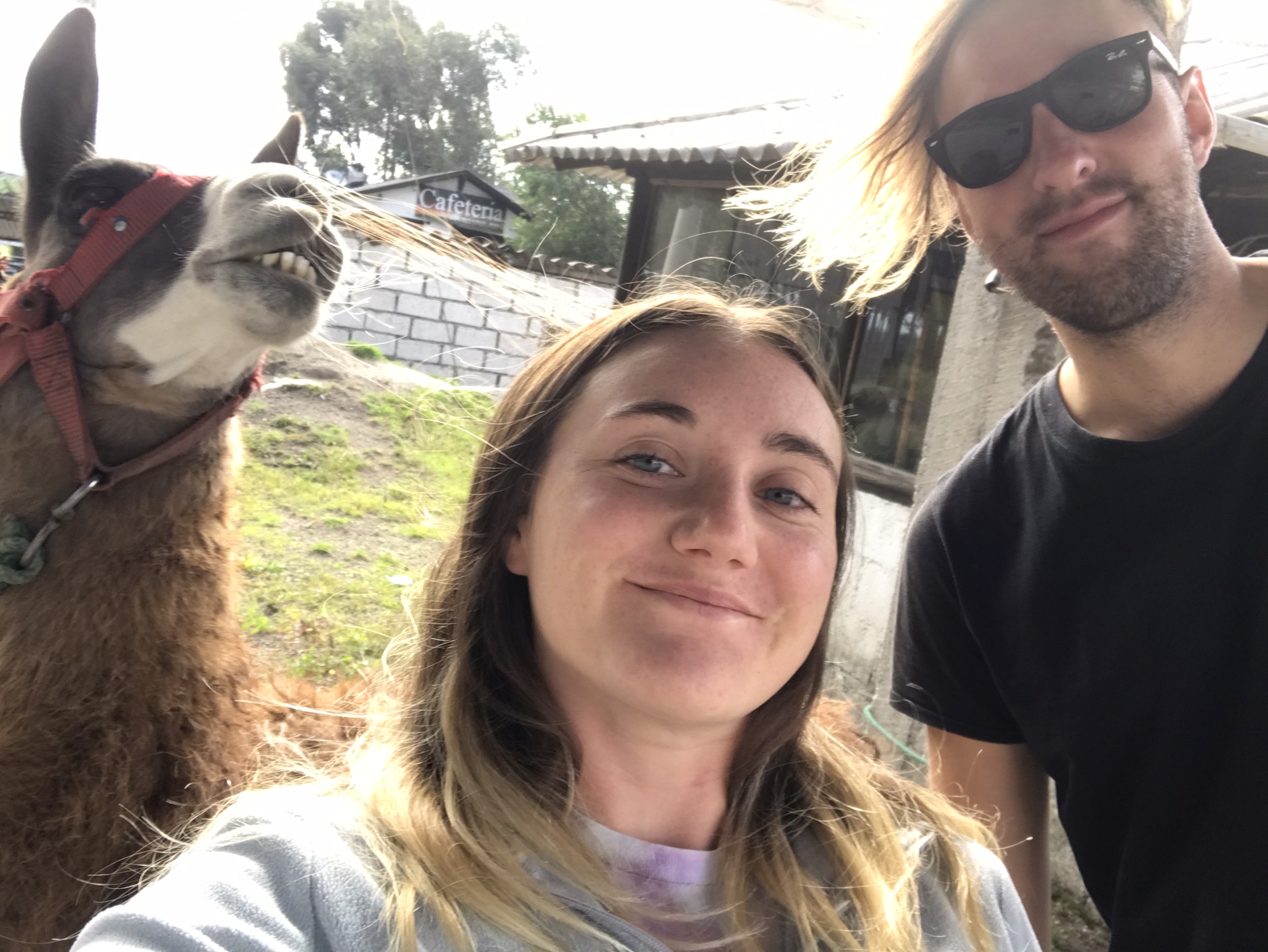Colombia was the first country we visited in South America. Colombia has had a tumultuous recent past and is mostly known to outsiders for drug cartels and political violence. However the country is doing its best to leave those days behind and is now a popular destination for many visitors thanks to its strong spirit of culture and community, as well as its abundance of natural sights. Check out my honest Colombia travel experiences, recommendations and opinions below.
Bogota, San Gil, Barichara, Santa Marta, Minca, Lost City Trek, Tayrona Park, Palomino, Cartagena, Medellin, Salento, Cali, Ipiales
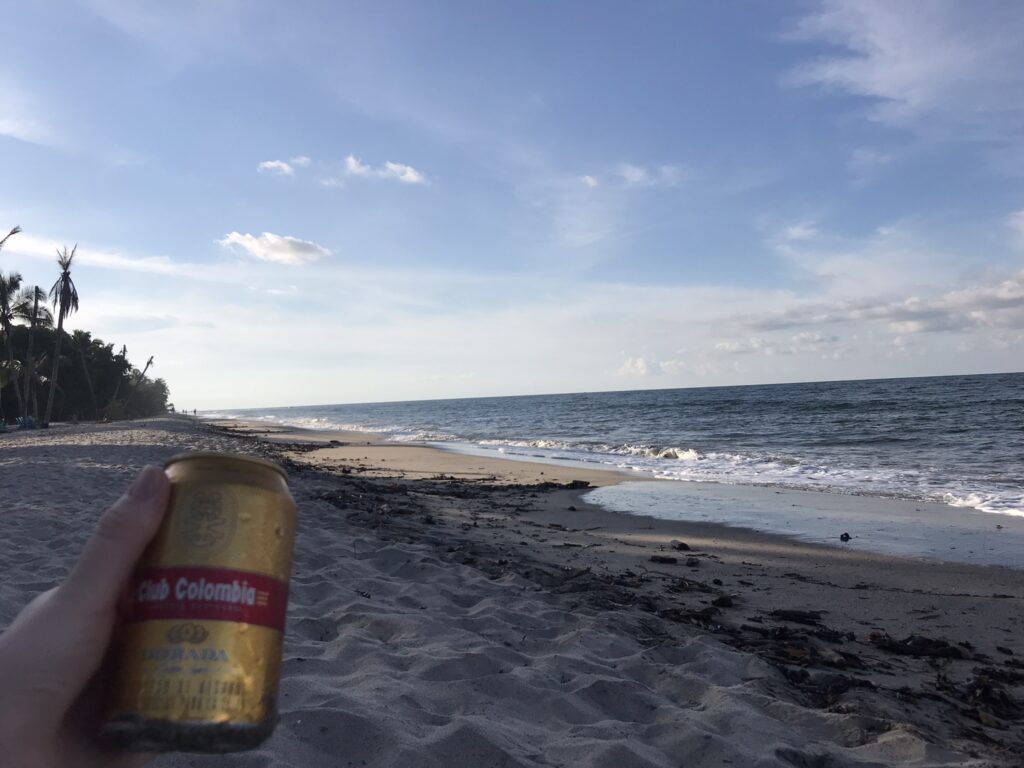
Enjoying a cerveza on the beach at Palomino
Things to know before you go
If you need a yellow fever vaccination, you can get one for FREE at Bogota airport, just go to the arrivals floor and look for the sign that says ‘vaccination’ – you can literally just walk in, be given the jab and a certificate which lasts a lifetime. This is really useful as vaccinations can often be expensive in other countries.
Fee free ATM: Davivienda
Phone sim card provider: Claro – we bought this at the airport but it was really overpriced! Avoid buying sims at the airport if you can, you’ll most certainly be ripped off and cheaper sim cards are available everywhere in most major towns and cities.
Uber works here but it’s technically illegal so you need to sit in the front seat next to the driver.
If you have to take a taxi, always agree on a price beforehand and make sure the taxi is licensed! Hotels and hostels can usually provide you with reliable taxis.
Food is very cheap in Colombia, we rarely made our own food partly due to the cheap price of meals in cafes and restaurants and partly because the first time I cooked in a hostel kitchen in Bogota we ended up with food-poisoning from a simple spaghetti bolognese! Buying all the ingredients for an elaborate meal from a supermarket is usually more expensive than just eating out. Rappi, a food delivery app is fantastic. We basically became addicts of this app. When you can have 2 burritos with drinks delivered for under £10, what’s the point of cooking?
Travel
We mainly used buses to get from A to B in Colombia. Busbud became our go-to website for booking bus travel, most providers and routes are available to book on there although be aware that Busbud does take a commission so tickets are usually a little more expensive to buy from there than if you buy in person at the bus station. Do not trust the travel time for buses listed online. By the end of our time in Colombia we just automatically added another 2 hours to the travel time listed on Busbud website. Expect delays and local residents requesting stops every 5 minutes in the middle of highways, cities or random places. This may be a new experience for you if you aren’t used to buses in Latin America, it can be ridiculously annoying when the bus continually stops but can also be used to your advantage at times if heading to a hard-to-reach location and need to get off yourself in the middle of nowhere.
Another quirk which will quickly drive you mad is that local sellers board the bus to sell snacks and drinks, after the 10th such stop to let a vendor on only for no one to buy anything and then stopping again to let the vendor off you might wish you’d just bought a flight.
Make sure you bring your passport with you as most bus companies request to see it when buying tickets, and again before you board.
Thefts do occur on buses, thankfully this didn’t happen to us but be aware if you need to place your rucksack in the hold to bring any valuables such as passports, money etc onto the bus with you in a smaller bag or wallet and keep them safely guarded on your lap or somewhere that they can’t easily be stolen. I always kept my small rucksack in the legroom between my feet with the strap looped around my leg to avoid it being stolen or tampered with. I highly advise against leaving valuables in the overhead luggage area as someone could easily grab it whilst you’re snoozing.
If you decide to pre-book and get to choose your seat, choose carefully. I would avoid sitting too close to the toilet as it can get smelly on long trips. FYI bring toilet roll and hand-sanitiser for bus journeys, it’s the norm for none to be provided. If it’s a double-decker bus the best seats are usually on the top deck at the front as you get more leg room and a better view. In other South American countries, you can opt for the more expensive seats on the lower deck as they usually recline more (cama) whereas the top deck seats only partially recline (semi-cama) and are usually cheaper.
Bus stations can be confusing, chaotic and crowded in Colombia and South America, not to mention high-risk areas for crime. We always used Busbud to decide which bus company we wanted to use and pre-booked tickets on the company website if possible or if not then via Busbud, it’s a little more expensive but at least guarantees a seat and lessens the overwhelming nature of the bus stations. Immediately when you enter you’ll be assaulted with shouts and cries from sellers trying to get you onto their buses, make a bee-line for the bus company that you’ve bought tickets with. Always check-in with the bus company physically at their stand even when you’ve bought tickets online, as they may need to exchange your online booking for a receipt which you need to show the bus driver. Bus stations usually have everything you need refreshments-wise so don’t stress if you haven’t packed your sandwiches for the journey, you’ll usually find something cheap to eat at the bus station. Never leave bags unattended. Don’t expect nice toilets at the bus station, you’ll be sorely disappointed. I would really recommend arriving early for your bus so you can check-in, find what gate the bus is departing from and load up on snacks for the journey. Bus stations in large cities can be huge and confusing, in some places you can even find shopping malls in the bus station, so don’t underestimate the time needed to do all of the above.
Safety
Safety in Colombia is a question that always comes up. Most, if not all travellers on the road asked us two questions: ‘did you feel safe?’ and ‘did you go out at night-time?’. The answer is that yes, we felt safe during the day in the main tourist areas however you need to be hyper aware of your surroundings; don’t flash phones, cameras or cash. And most importantly, do not dawdle or wander into areas you don’t know, make sure you have an idea of the route you need to take and if you don’t know the way to your next destination then try not to wander around aimlessly in back-alleys or deserted streets. We did not go out after dark in Colombia with one exception I will mention later, this is because (I think) I read too much about the crime situation and other people’s experiences before we went to Colombia which meant I was excessively cautious to avoid danger. I scared myself before giving Colombia a chance, for this I am slightly regretful but anyhow we weren’t robbed, drugged and nothing bad happened to us. Our city tour guide in Bogota did tell the group not to go to certain areas after dark so this backed up my paranoia. When we first arrived in Bogota we were in a supermarket and the sun was going down, in a scene reminiscent of a wild west show-down mixed with Cinderella we were getting more and more anxious about getting back before dark to avoid any issues (cue western movie theme music). In reality it is probably best to avoid wandering around too much after dark in big cities or less touristy areas, but you (probably) won’t be immediately attacked if you do find yourself out after dark.
For more info on crime and safety in South America check out my blog post here!
Bogota
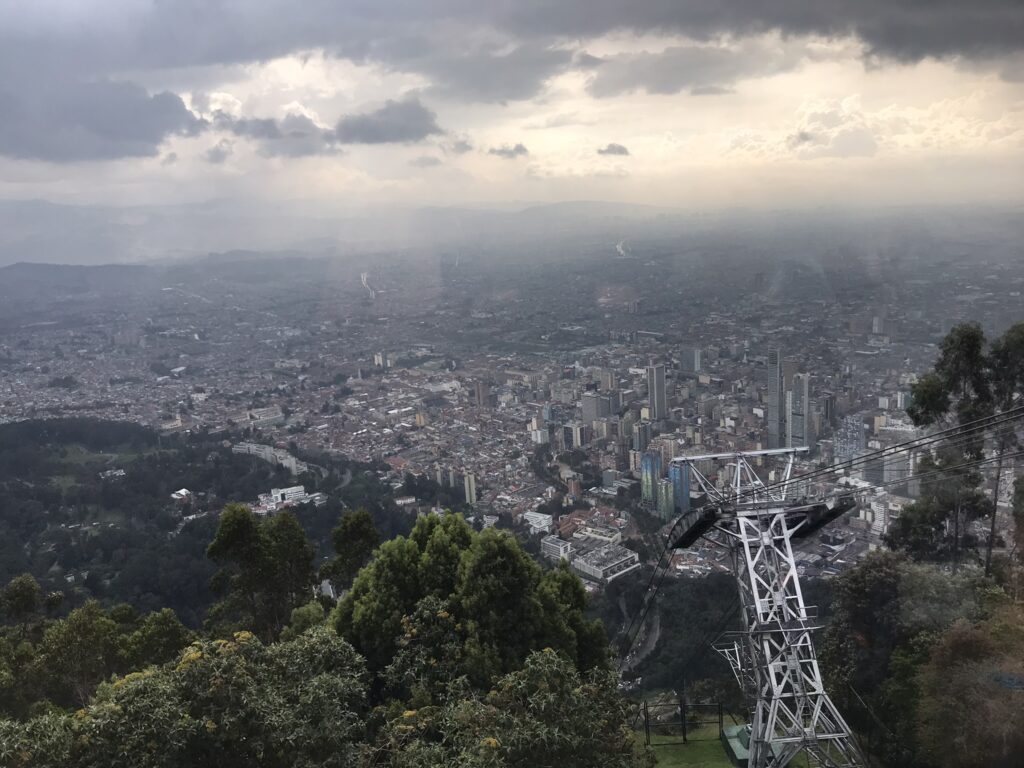
View from the top of Monserrate
A good starting point to explore Colombia, however don’t get bogged down in Bogota, it’s a huge city but some say it lacks culture compared to the rest of Colombia. The main tourist neighbourhood is Candelaria, which is right in the centre of the city and generally is one of the safer areas to walk around. The weather in Bogota was really changeable during the day so prepare for all weather conditions (except snow I guess) when leaving your accommodation, even if it seems like clear skies outside. We found this out the hard way by not taking a rain jacket out with us only to be caught out whilst on a walking tour and looking like drenched gutter rats by the end.
Activities
- City walking tour (booked through Guruwalk)
- Gold Museum (insanely intricate gold work, amazing! Free on a Sunday?)
- Botero Museum (free entry, just try not to laugh at the paintings)
- Cable car to Monserrate (long waiting time so go early)
- Museo Quinta de Bolívar (this is a house that was formerly used by Colombia’s liberator, Simon Bolivar. You will hear a lot about Bolivar in Colombia. The house is on the way to Monserrate cable car station so you can combine the two in a day)
- Graffiti walking tour
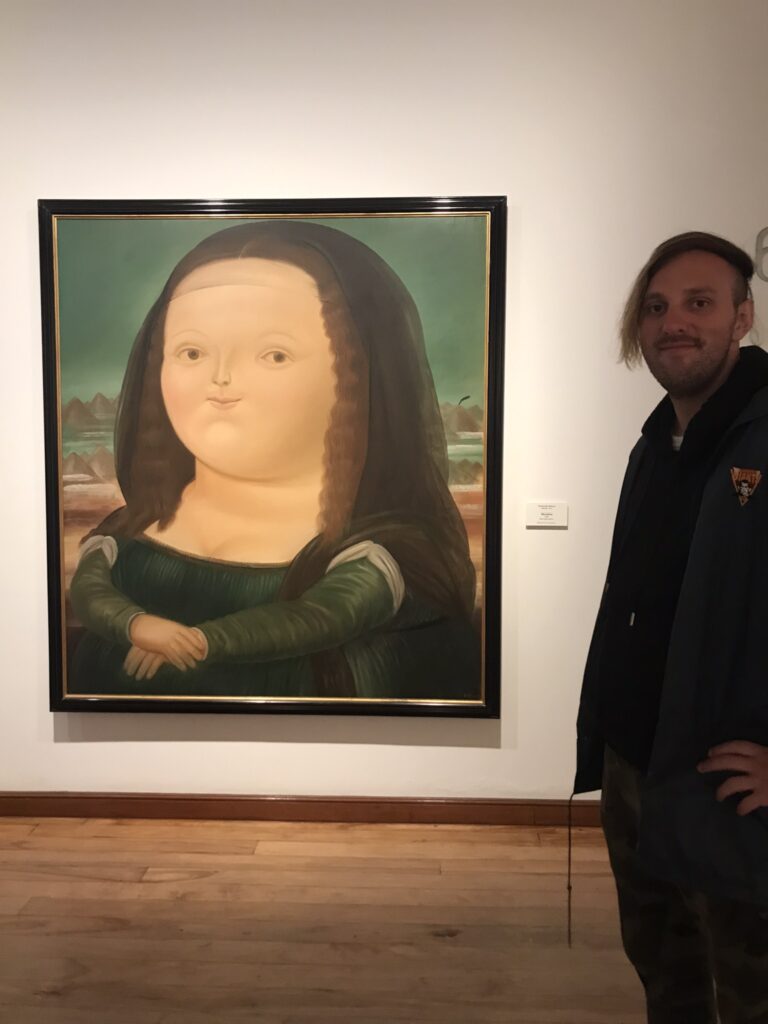
Exploring the weird and wonderful world of Botero
Foodie Places
- Origen Bistro
- TINTOrería
- Free Food Tour – excellent, highly recommend! You only pay for what you eat so you can share food with a friend/travel companion to save costs. At the end there was a coffee workshop which was really good too.
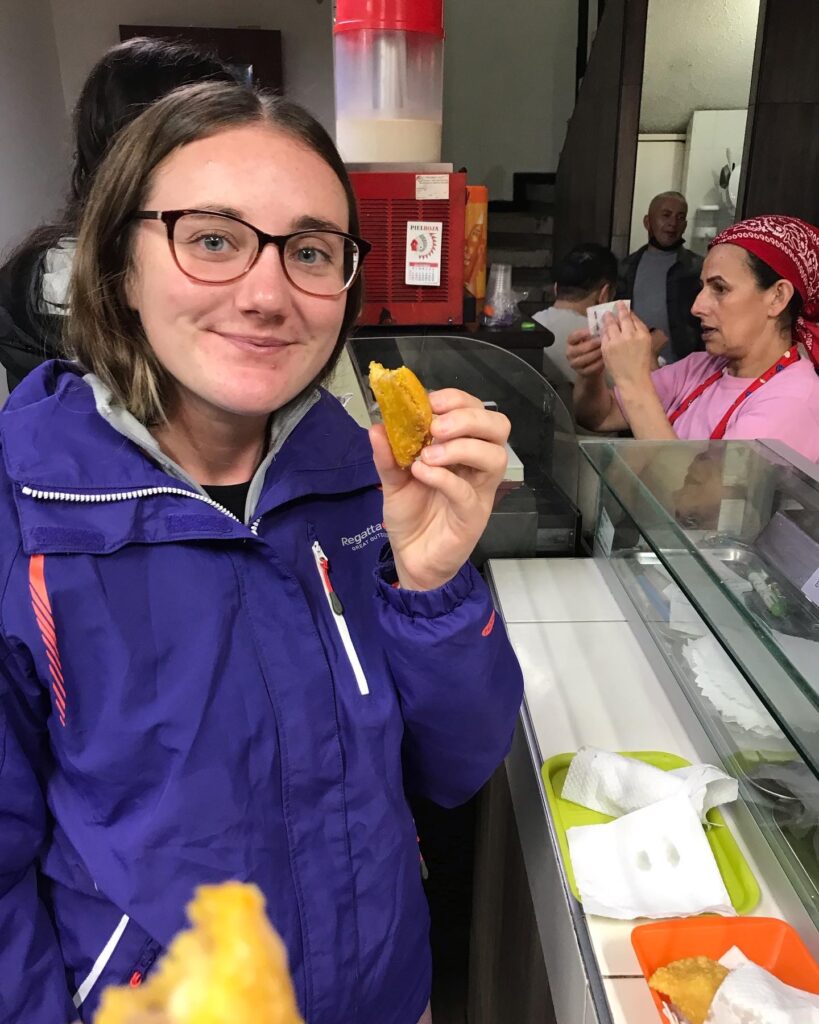
Eating too many empanadas on the Food Tour
Accommodation
R10 Hostel – a bit of strange vibe as it was a ghost-town when we were there. We also got food poisoning here but I think it was down to my cooking, oops.
San Gil
San Gil was a stopover for us between Bogota and Santa Marta. I was still recovering from food poisoning so wasn’t able to eat or appreciate much. Most visitors to San Gil are looking for adventure sports such as rafting and canyoning in the nearby countryside. We did not do this as we were traveling on a budget and also recovering from food poisoning, however San Gil is known as an adventure capital in Colombia. Outside of this there is not a really lot to do in the town, we used it as a base to rest and visit Barichara.
Activities
El Gallineral Natural Park – a nice enough nature park near the city centre. Watch out for the squirrels, you can buy food to feed them, you’ll find them on the trees near the entrance – use the spoon attached to the tree to feed them. I did not and one scratched me which led Dan to spiral into thinking I had rabies.
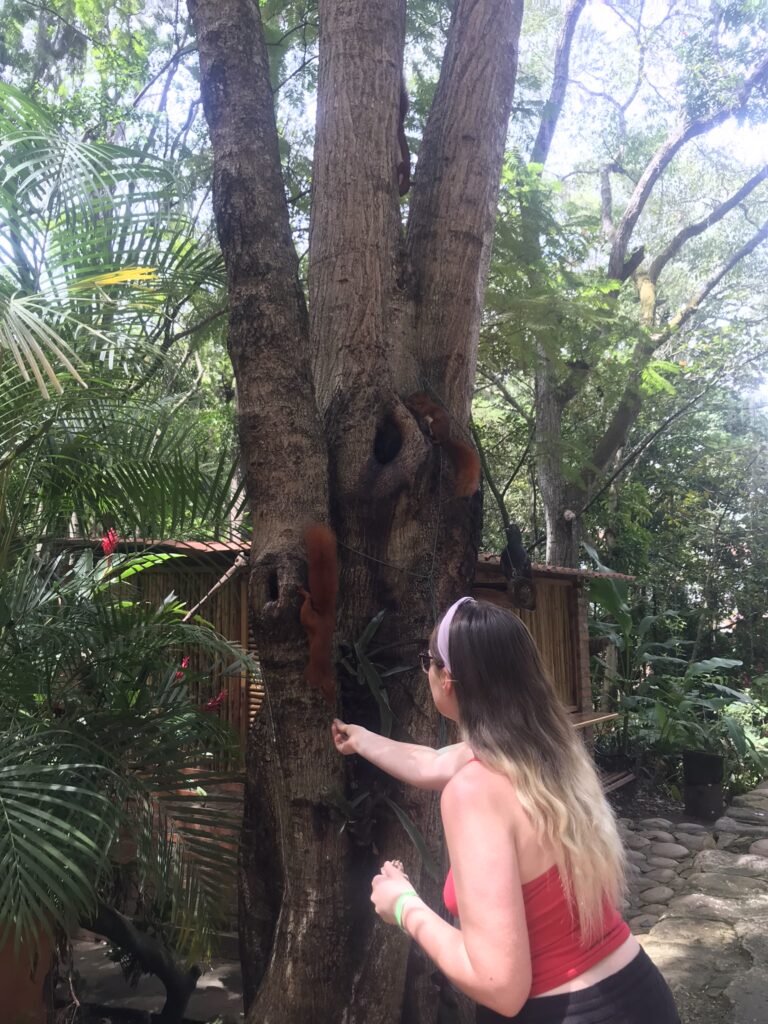
Don’t copy me and feed the squirrels by hand
Foodie Places
Gringo Mike’s – you won’t be disappointed here if you have a craving for Mexican food and huge portions!
Accommodation
This is Colombia hostel – quiet hostel that was more like a hotel really, very helpful staff and the room had a TV which was great when we were bedbound with food poisoning. Highly recommend!
Barichara
We decided to visit Barichara on a day trip from San Gil, it’s easy and much cheaper to do this independently rather than with a tour group. Just head to Terminalito Provincial (the bus station in the centre of San Gil at location 6.556610245145811, -73.13684218957899, not the inter-city bus station just outside town) and buy a ticket. The collectivo minivan drops you off at the main square in Barichara and returns to San Gil from the same place that it drops you off. Barichara is a quaint colonial-style town, ideal for wandering around. We were visiting out of season but there seemed to be more hostels than tourists here! We spent a few hours looking around and grabbed some lunch and juice at a local cafe, notable sites include the Barichara viewpoint, various churches and the main park. Some people also like to complete a hike between Barichara and the nearby town of Guane.
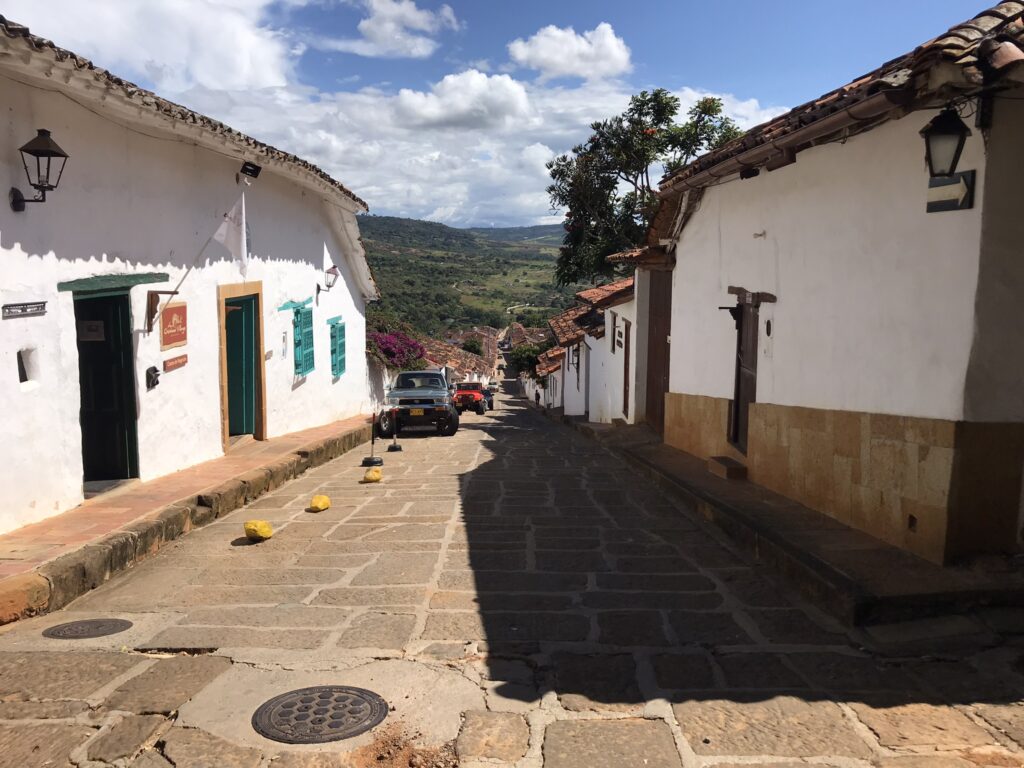
Barichara is a quaint, peaceful village close to San Gil
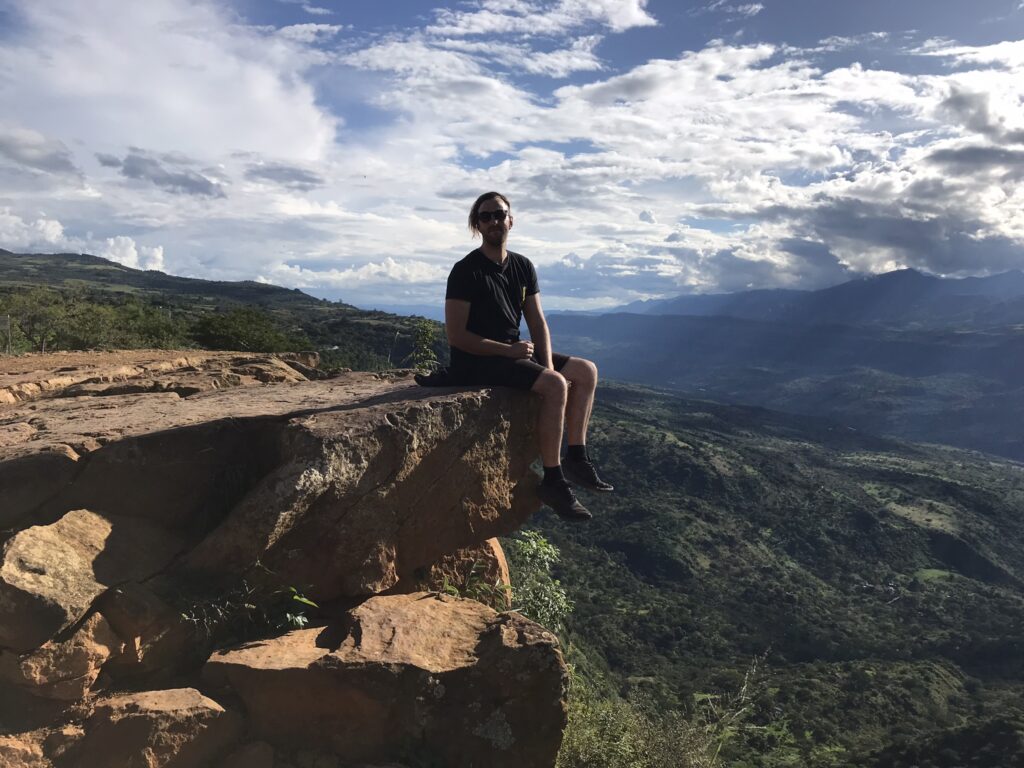
Barichara also has breathtaking viewpoints
Santa Marta
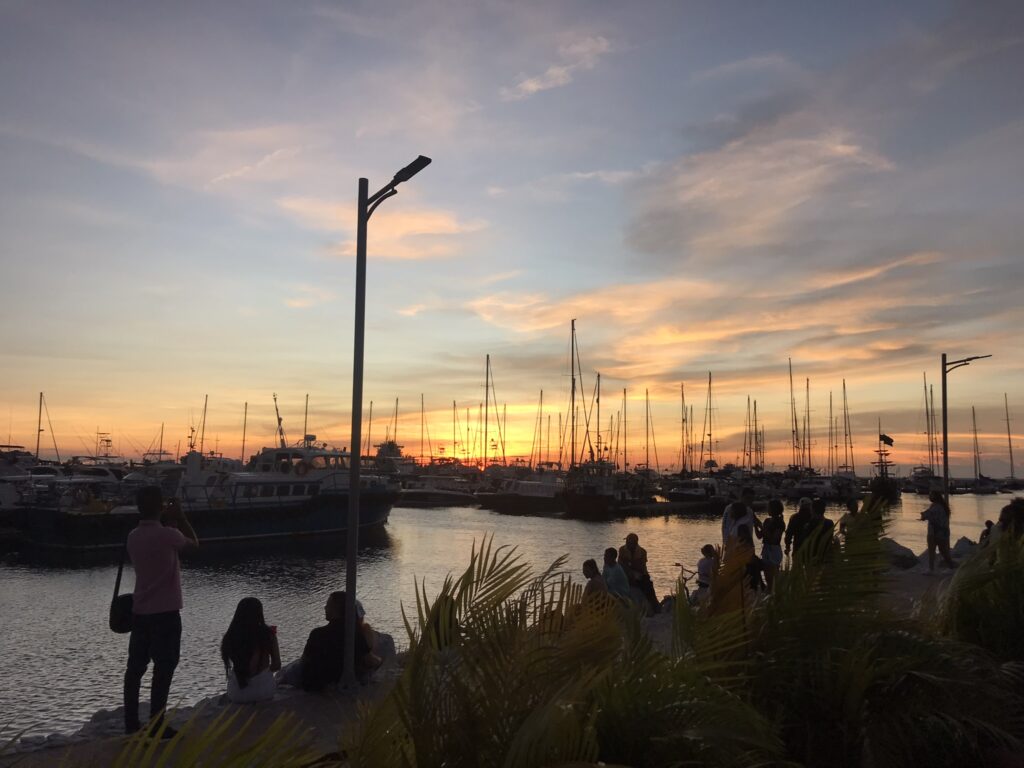
Sunset at the Marina, Santa Marta
We ended up using Santa Marta as a base to bounce around the area for two weeks while waiting for Tayrona Park to open. FYI the park closes a couple of times a year, so be sure to check that it’s actually open before heading to the area if this is something you want to visit! While we were waiting we had plenty of time to explore other nearby areas including Minca, Palomino and completing the Lost City Trek. Santa Marta is one of the oldest cities in South America but is not the prettiest or safest city, it was the only place we visited in Colombia where we heard first-hand stories from other travellers of daylight robberies and muggings. When driving through the outer city limits there’s a lot of poverty visible. There’s also a large population of Venezuelan refugees here due to the close proximity with the Venezuelan border. We spent most of our time here relaxing and recuperating from the Lost City Trek and various trips around the region.
Activities
Quinta de San Pedro Alejandrino – the place where Simon Bolivar spent his final days, his death-bed is still there along with some information about the other historical uses of the estate, a large memorial to Bolivar and an art gallery. This is a little out of town and will probably appeal mostly to people who are interested in the history of Colombia or Bolivar.
Lost City Trek (see below for details)
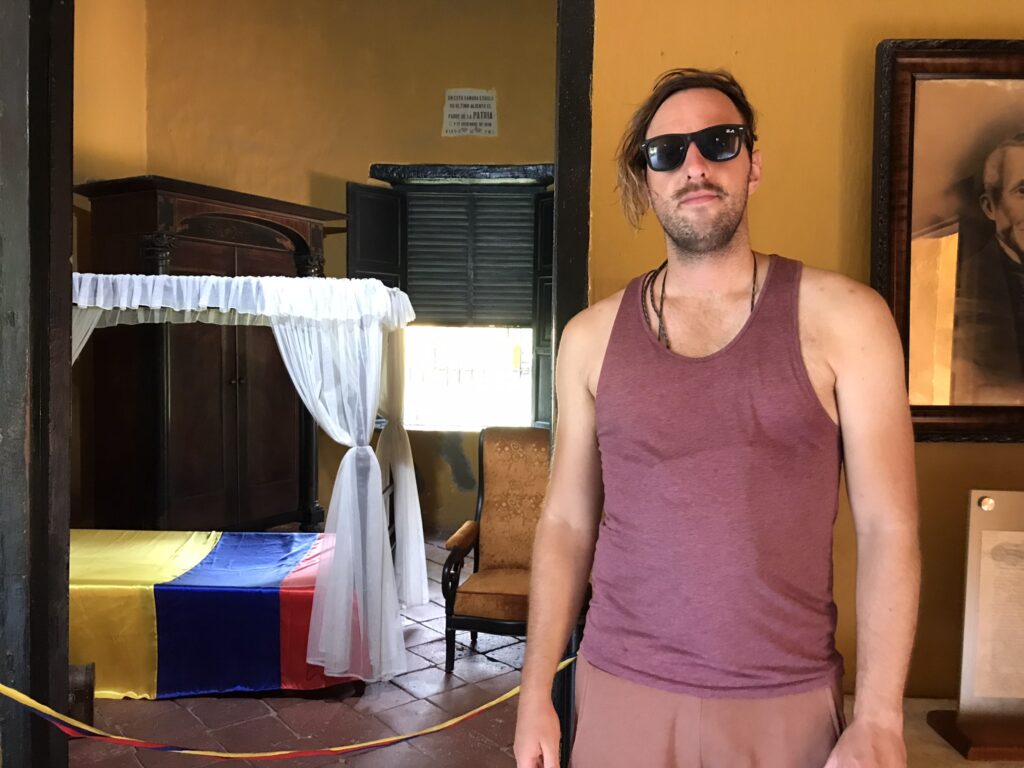
Deathbed of Simon Bolivar
Foodie Places
SMR burger house – choripan sandwich is to die for! We got takeout from here about 4 times during our long stay in Santa Marta.
Caribbean Team – amazing juice and fab burgers and mac & cheese, this place is in a great location by the marina and is popular with locals
Munchies Brunch
Maharaja India Restaurante – only open for lunch, vegetarian food only but great deals on a set tray menu
Accommodation
Fatima Hostel – cheap and cheerful hostel with a pool. I really recommend booking somewhere with a pool as it can get really hot and humid in this region during the day.
Lost City Trek
The Lost City Trek is one of the most popular activities for travellers to Colombia, it is a four-day trek through the jungle to reach the Ciudad Perdida or Lost City, an ancient citadel of the Tayrona people located high in the mountains. The trek can only be completed as part of a group tour with a local guide, the tours depart from Santa Marta are there are tours setting off every day.
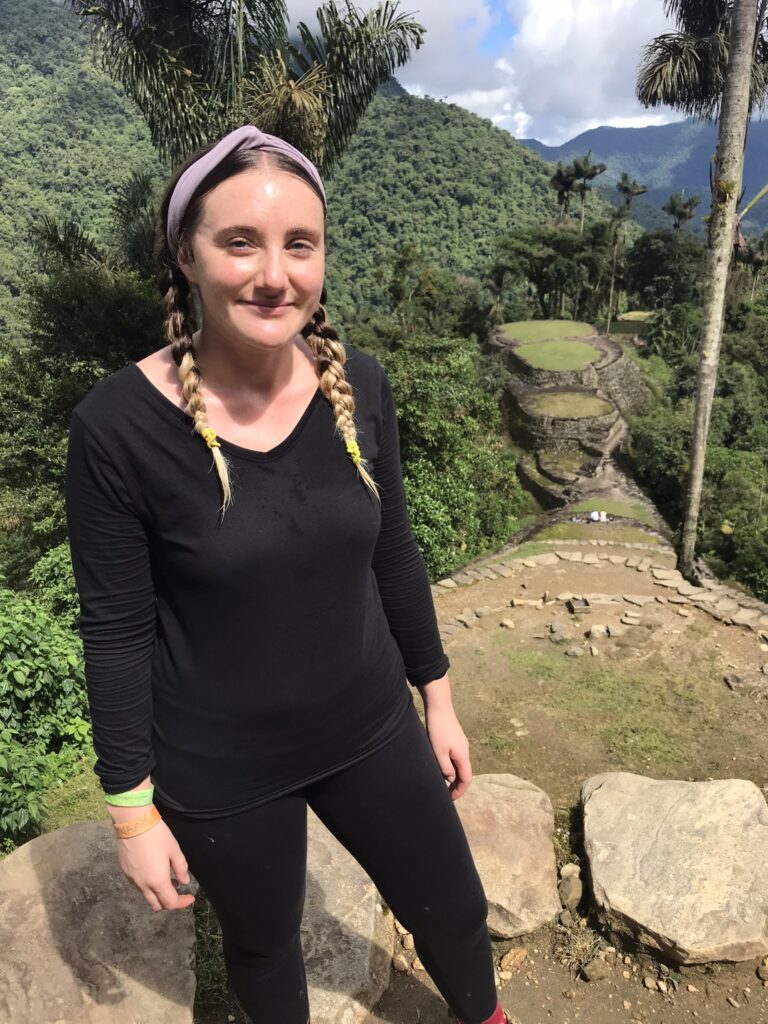
After ascending over 1000 steps we finally reached the Lost City!
This trek is not for the faint-hearted or to be done on a whim (like we did!). It involves trekking mostly uphill in the heat of the jungle for around 8 hours each day. You need to carry your own bags and the trails are not what you would consider typical hiking trails, they are narrow, winding and rocky at times, and can be dangerous when wet/slippery. You will sweat in places you didn’t know you could sweat, I found that my arms and upper lip got sweaty, ew!
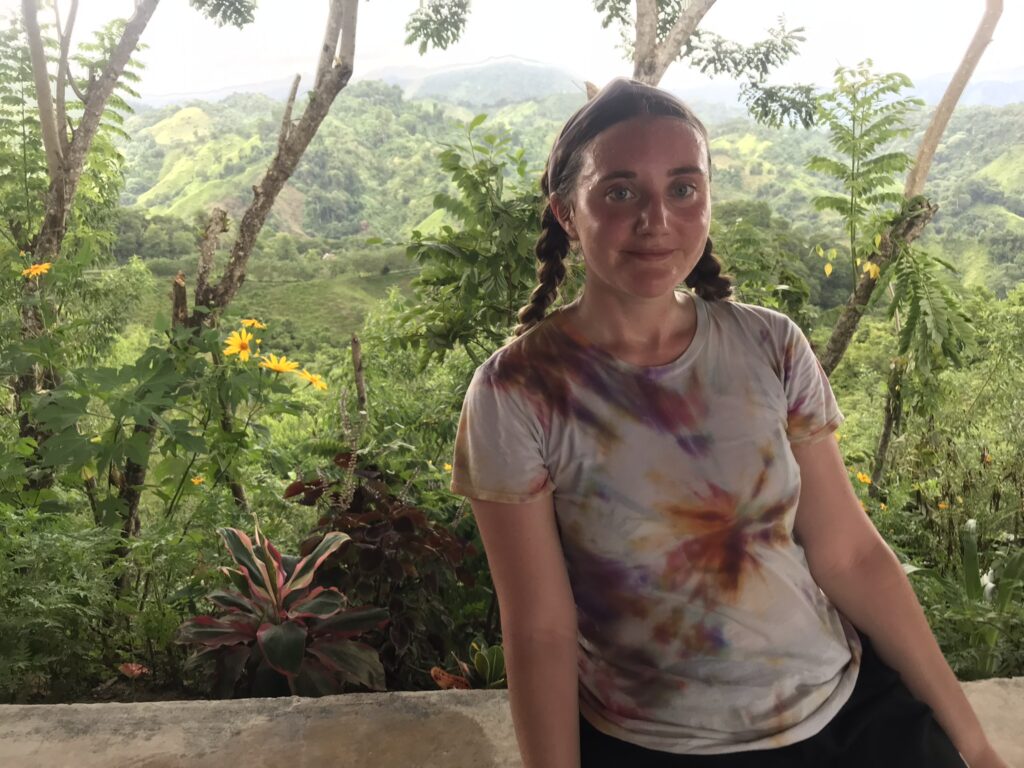
Drenched in sweat. This trek is not for the faint-hearted.
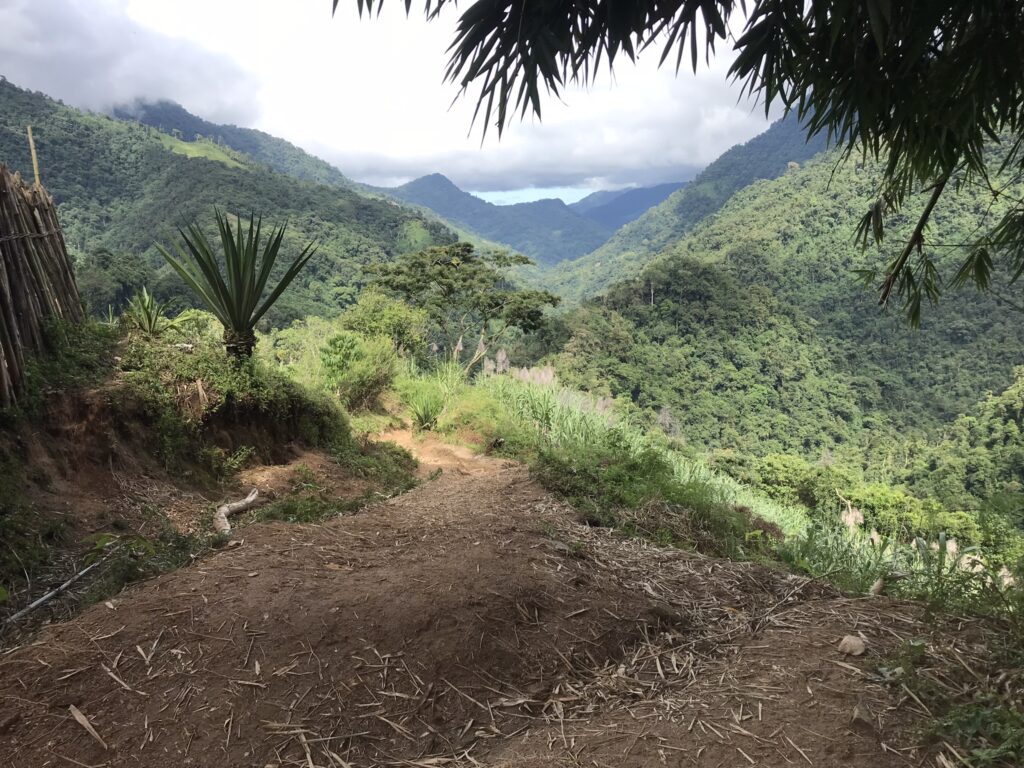
At the top of a hill – a lot of the trek is uphill
The trek was very physically demanding and difficult. Two of our 6-person tour group were physically unable to make it back on their own steam and needed assistance with mules. Some members of the other groups that were trekking on the same days as us had to stay an additional night at rest camps as they were too exhausted to continue, while we saw many others who had resorted to paying for mules. The mules are not really an optional part of the experience, they involved bartering with the local indigenous communities and seemed to be considered an absolute last-resort by the guides for people who were completely stuck. The route was very basic and undeveloped, we spent a lot of the time drenched in sweat, covered in mud and had to throw our shoes away after the trip, while Dan also badly cut his hand at one point. The rest stops and fresh fruit provided along the trail were small respite. Despite this we had a great time on the trek, passing through local communities and amazing views and nature, bathing in natural pools at the rest camps, reaching the Lost City and even encountering the elusive local chieftain who gave a blessing to some members of our group.
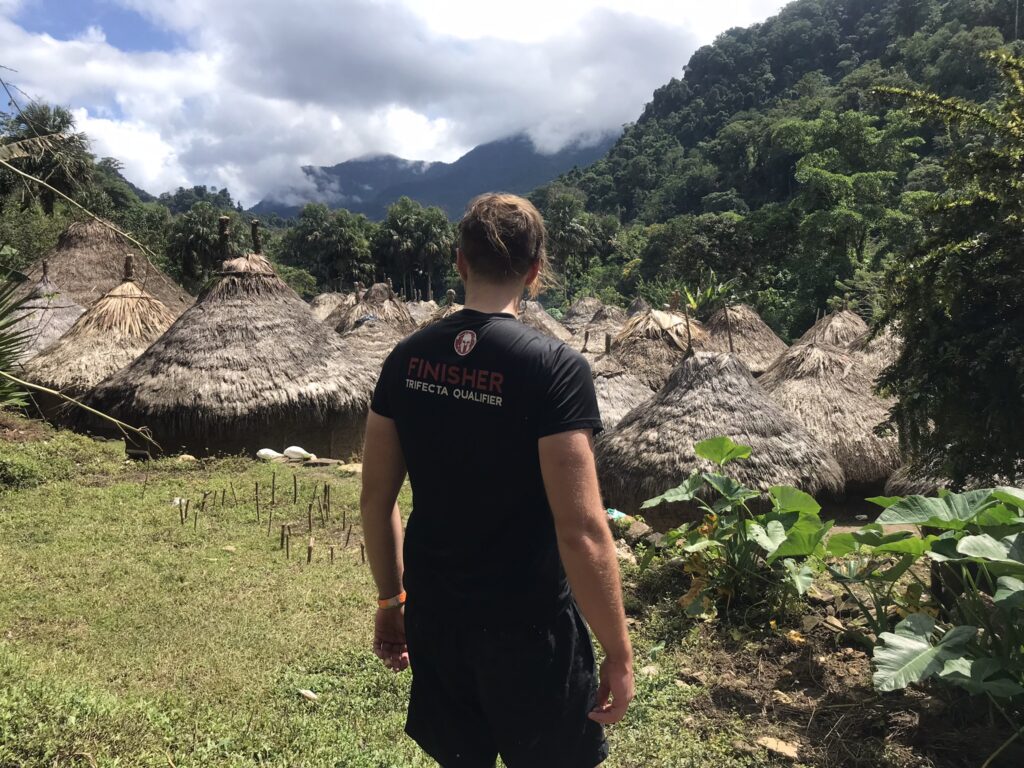
The trail goes past an indigenous village – it was fascinating to see community life
The trek was a great experience and I definitely don’t regret it, however it was vey tough in the mud and there are some things I wish I’d known before embarking on the trek on a whim. Check out my blog post with survival tips for the Lost City Trek here!
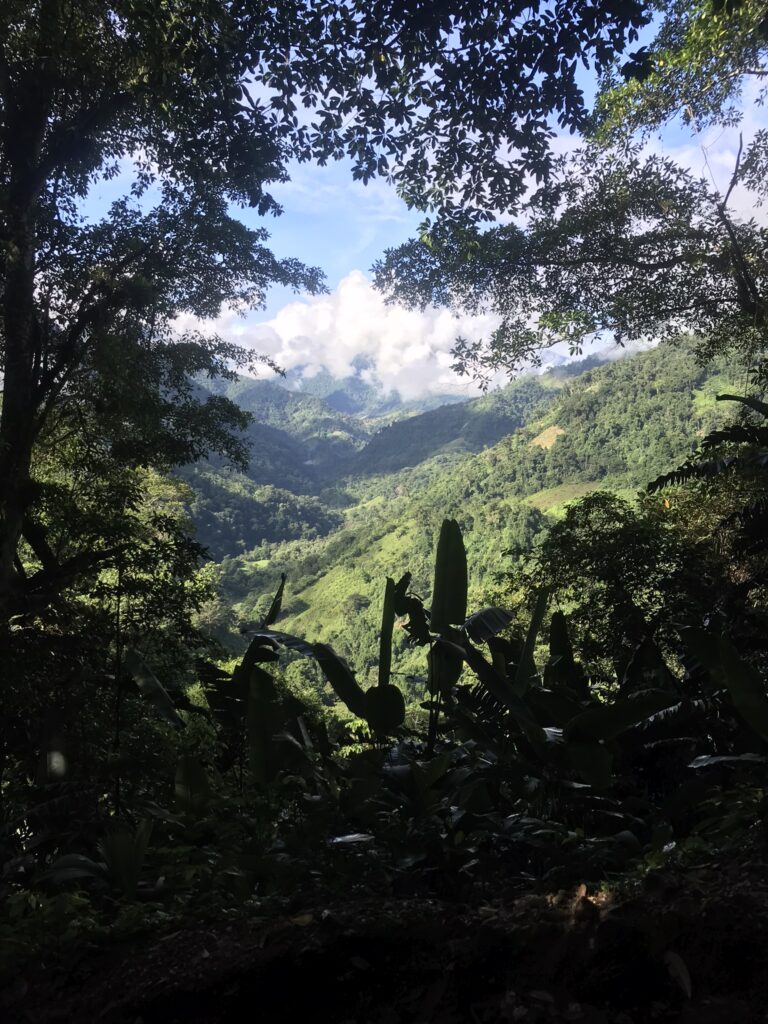
Peeking through the canopy
Minca
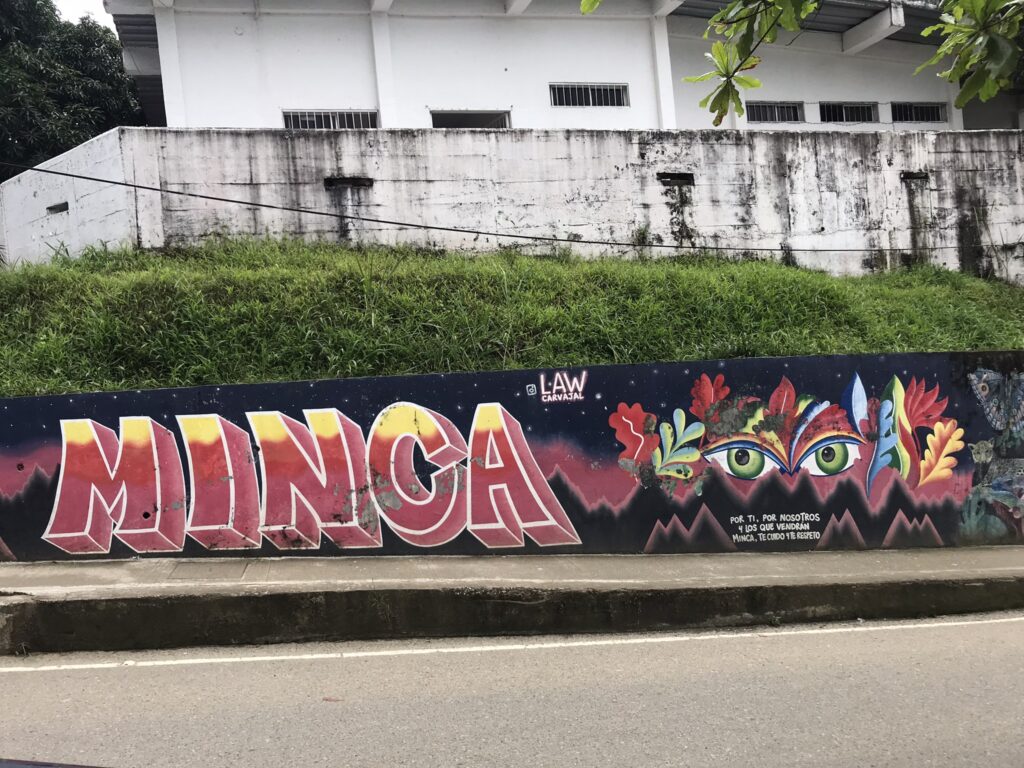
A great jungle getaway not far from Santa Marta. Simply head to the main market in Santa Marta (google maps: Bus Stop To Minca, Calle 12, Carrera 9) and jump into a collectivo, these mini-buses leave sporadically when they’re full, there are no set times, you just turn up and wait for the minivan to fill up. Long sleeves and trousers are a MUST here. You need to literally coat yourself in insect repellent too. I ended up with over 100 mosquito bites, no word of a lie, after we went walking through the jungle in the dark to find a mysterious restaurant that was recommended by our host.
Accommodation
Jungle Joe’s Ecolodge – highly recommend! Plus the breakfast is really good and you get discounts on Joe’s tours.
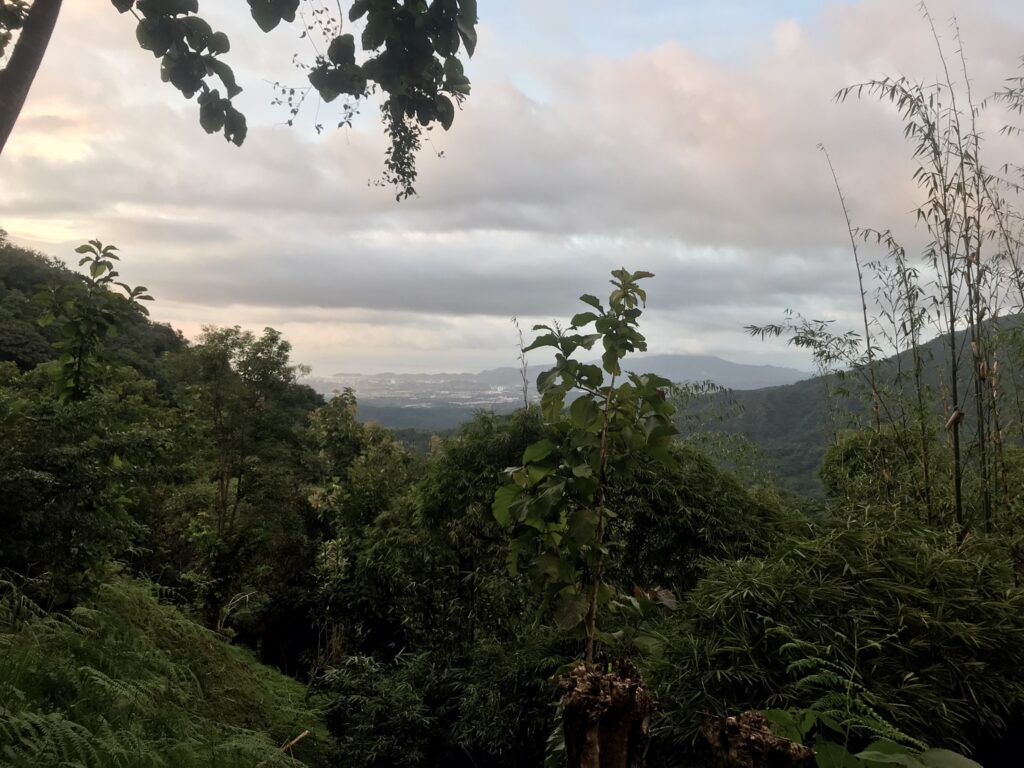
This was the view from our room
Foodie Places
Somewhere in the jungle! Joe recommended a restaurant that was close to his accommodation, we needed to walk and scramble through the jungle down dimly-lit trails but eventually found the place which served some great local food and beer.
Amora Cocina Saludable
Activities
Marinka Waterfalls – these waterfalls are a little way out of town in Minca, there are two ways to get to this waterfall, you can either walk or get a lift on the back of a moped with one of the many guys offering rides from the centre of the village. We ended up riding there on the back of a moped and feared for our lives. It was the rainy season so the bike was sliding all over the muddy ground and there was no traction. Plus it was towards the end of the day so the ground had been mushed up already by many mopeds and tourists. Safe to say we walked back!
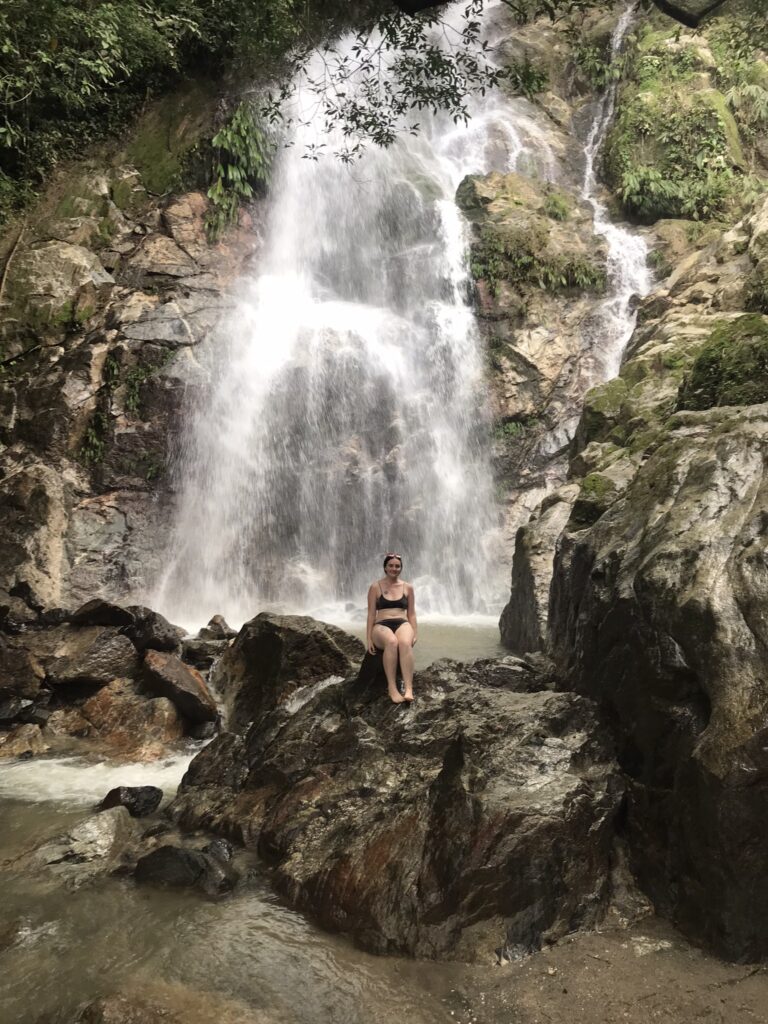
Pack your swimming costume – a dip in the pools at Marinka is great on a hot day
Jungle Tour with Birdwatching Adventures (Jungle Joe Minca Tours) – we got a discount as we were staying at Jungle Joe’s lodge, however the tours are available to anyone and can be booked at Joe’s office in the village. Jungle Joe’s daughter led us through the forest, pointing out flora and fauna along the way and taking us to another waterfall and natural pool to swim in. This tour ended with a chocolate workshop and lunch.
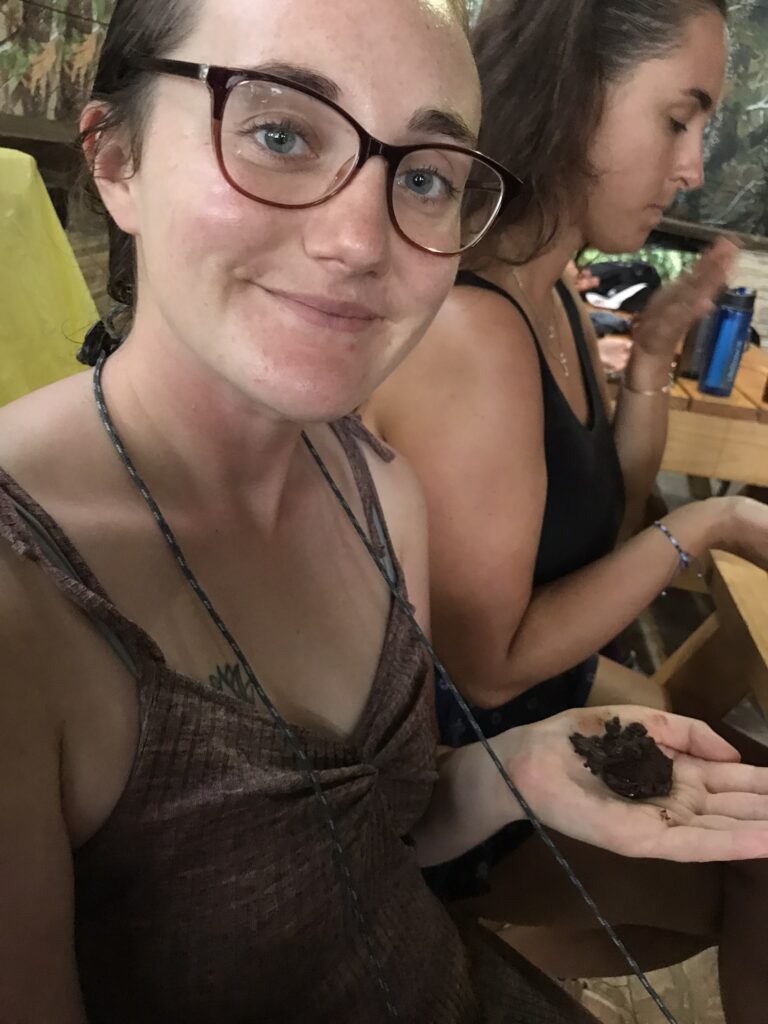
Jungle Joe’s chocolate workshop was a hit
Palomino
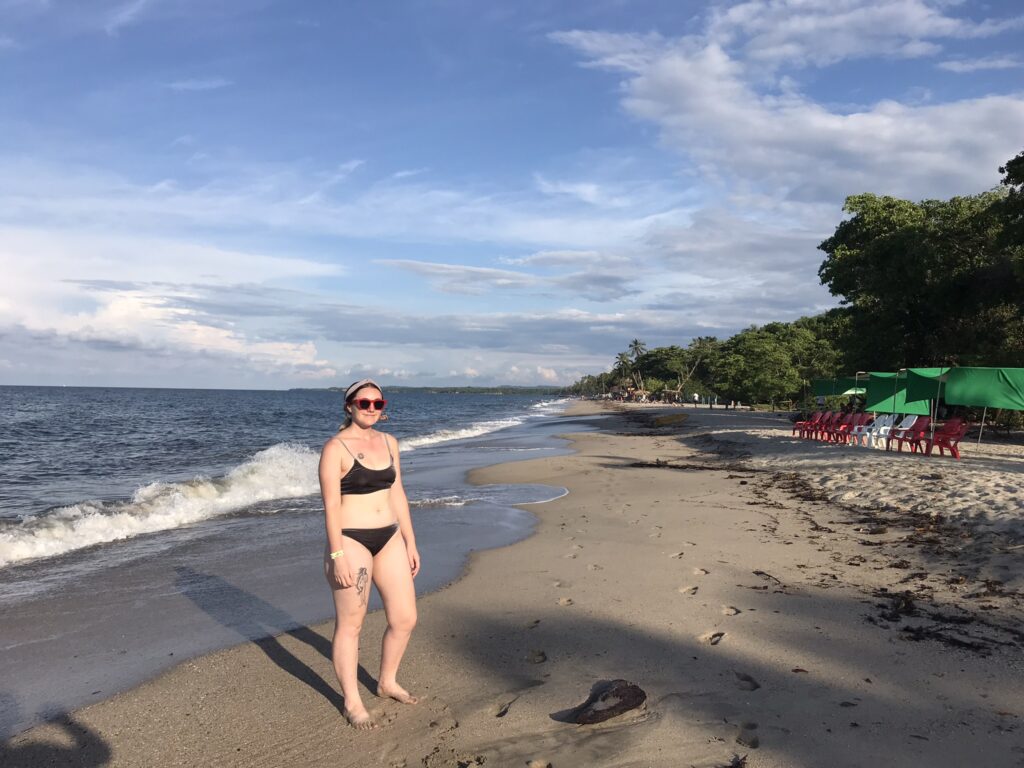
Relaxing at the beach is the best thing to do here
If you need to get away from the hustle and bustle of Santa Marta for a couple of days and relax at the beach, this is the place for you. The same bus travels from Santa Marta via Tayrona Park to Palomino (google map: Bus Parque Tayrona Calle 11 Carrera 9). The town looks very dodgy from the main road where you’re dropped off but once you head towards the beach via main street, you’ll find a backpacker paradise. Vegan restaurants, tiki themed hostels, Mexican restaurants, beach bars & surfing schools.
Accommodation
Palomino Sunrise – I cannot recommend this place enough! Best free breakfast we ate in Colombia (and we ate a lot of those)!
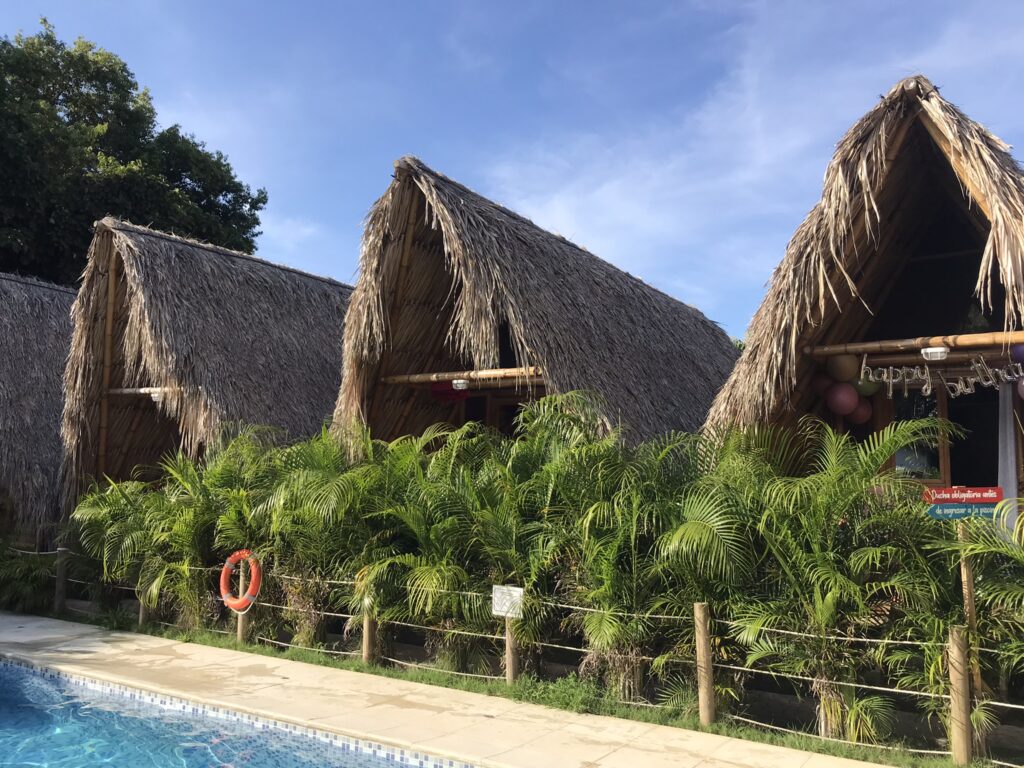
What a view to wake up to!
Activities
- Drinking beer on the beach, local guys offer cans of beer for cheap prices. The beach at Palomino is not good for swimming, just a place to relax.
- Tubing on the river (again with a can of beer)! The tubing involved a short walk through the jungle carrying the tubes and then gently floating down the river to the point that it meets the sea. This was a super relaxing activity and one of the best things to do in Palomino, we took some cans of beer with us and enjoyed a cold one while bobbing along.
Foodie Places
- La Chavela taquería
- The Tiki Hut (best lasagna in Colombia!)
Tayrona Park
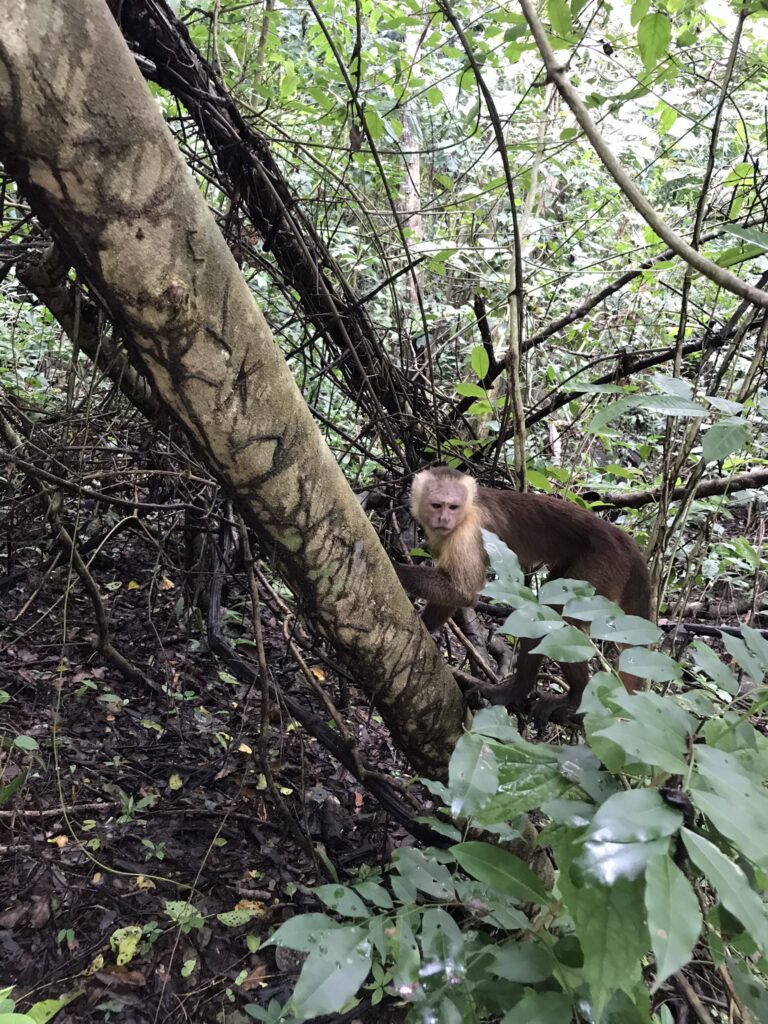
Monkeying about
There are two ways to experience Tayrona Park, you can either stay inside the park or, like we did, stay at a hotel/hostel outside the park/near the park entrance and get up early to queue to visit for the day. I can’t comment on the first option but I can say that it would definitely give you more time to explore the park. The park entrance closes at a certain time so all day-trippers (like us) need to leave before the gates are closed, this deadline hangs over you and means you have to turn back earlier than you want to.
We used the eastern entrance ‘El Zaino’ near Naranjos (google maps: Taquilla El Zaino). The area around the Zaino entrance has a small settlement including a few shops, restaurants and some hotels, including the one we stayed at, the main highway between Santa Marta and Venezuela passes through here and it did seem a little sketchy at night. We came from Palomino, the bus to Tayrona is the Santa Marta-Palomino line and takes around an hour from Santa Marta (bus stop in Santa Marta listed above).
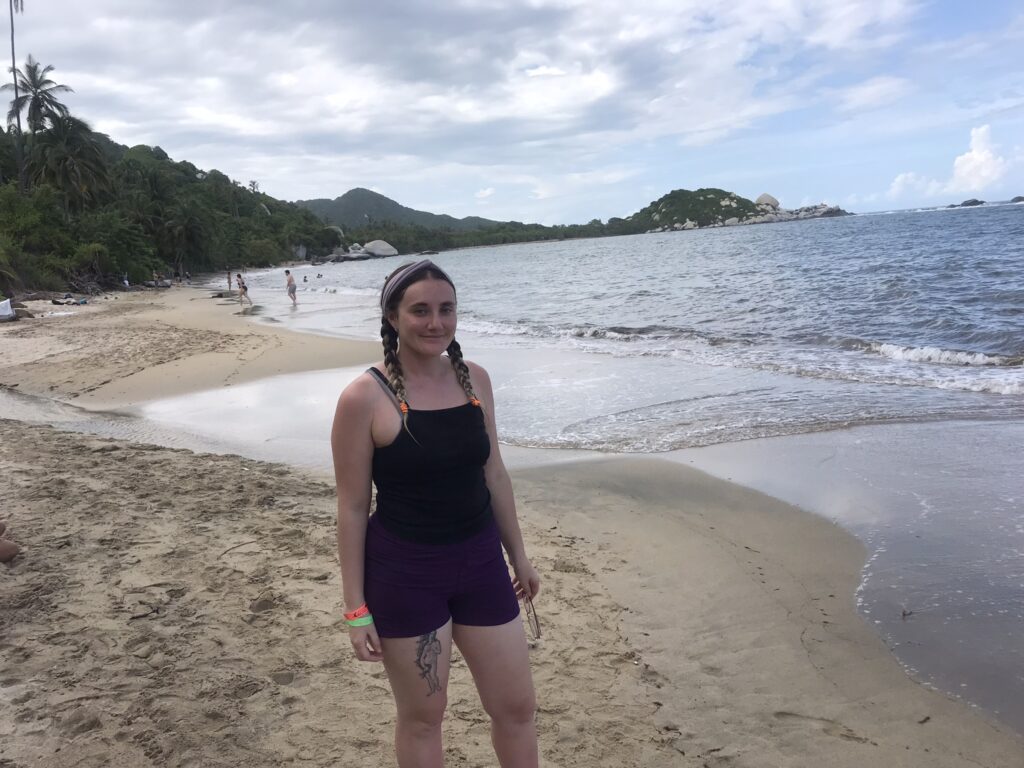
You can’t actually swim at many of the beaches in Tayrona Park
You can’t swim at any of the beaches closest to the entrance at Tayrona so you need to hike for a couple of hours to get to a beach where you can go into the sea. The trails are quite obvious so you won’t get lost, plus there are lots of other visitors on the paths. We didn’t want to miss Tayrona as it is considered one of the major attractions of this part of Colombia, and Colombia travel in general. However in the end, after completing the Lost City Trek, visiting Minca and Palomino etc we found that Tayrona Park was a little underwhelming. The walking trails from one beach to the next actually took much longer than I expected, especially in the sweltering heat, and as we were visiting for the day we seemed to spend most of the time walking to the beach, trying to find somewhere to get food and then walking back to get out before the park entrance closed for the day. It was interesting seeing monkeys in their natural habitat but there are better beaches nearby, in my opinion, which don’t take hours to hike to. We preferred the beach at Palomino.
My opinion is probably tainted by the fact that we waited for 2 weeks to go to Tayrona Park and had experienced a lot of similar things in the region already, and also the fact that we only visited for the day rather than staying overnight, which barely gave us enough time to properly explore the park. We chose to do this as the accommodation in the park seemed to be limited, mostly consisting of basic facilities such as hammocks with mosquito nets, and was also quite expensive. Plus the restaurants in the park were a bit underwhelming, one restaurant didn’t have any food at all and from the look of the preparation area I wouldn’t trust the food from there anyway. We ended up skipping lunch and eating at a restaurant outside the park entrance. If you’re staying overnight, bring enough food supplies.
Accommodation
Recuerdos del Tayrona – just outside Tayrona park at El Zaino, this was okay for one night.
Foodie Places
Restaurante las Acacias – cheap road-side joint with plentiful portion sizes. This place was a lot better inside than it looked from the outside.
Cartagena
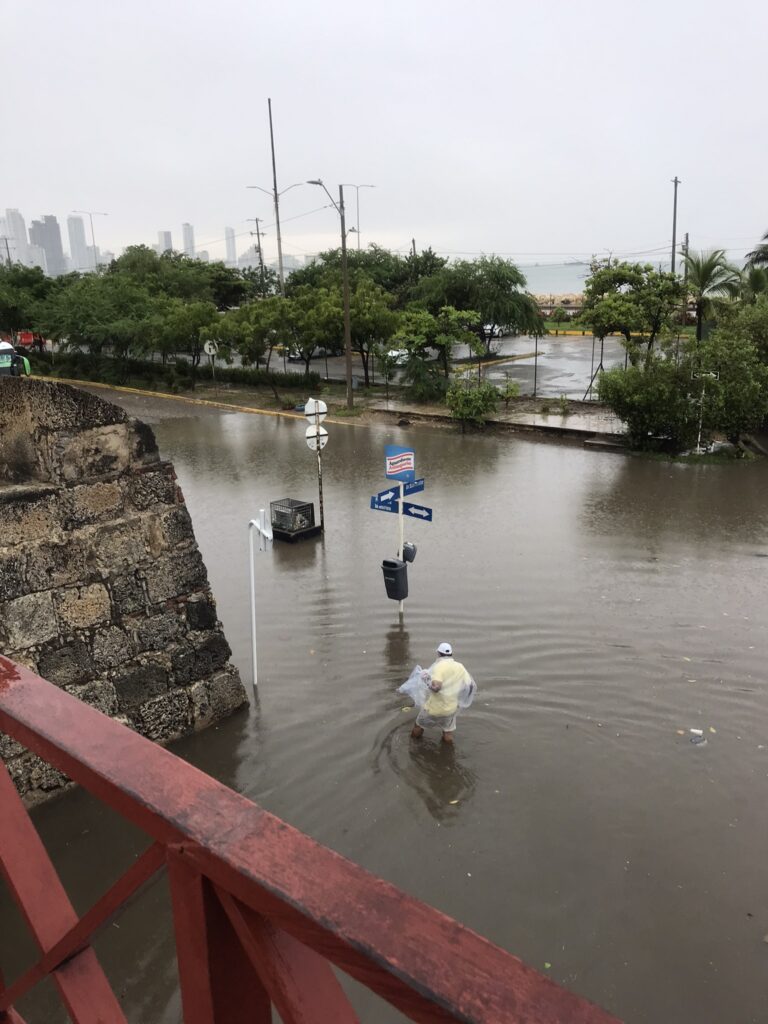
Floodwaters in Cartagena
Cartagena was flooded when we visited, the flood water was up to our calves in the walled historic centre. A complete wash-out. We spent most of our time hiding from the constant rain and watching American Football on ESPN and Fox Sports. We were told this is because Cartagena is below sea-level and the water drainage system is not effective when dealing with a deluge. On the plus side, the floods cleared up just before we left so we were able to see most of the main sights, and the weather meant we didn’t have to deal with the crazy humidity or many of the hasslers than visitors often report in Cartagena.
Accommodation
Quintas by Maos Hostal – cheaper than staying in the Old town or in Getsemani, within walking distance of the main attractions and the private room had a TV which was great during the floods!
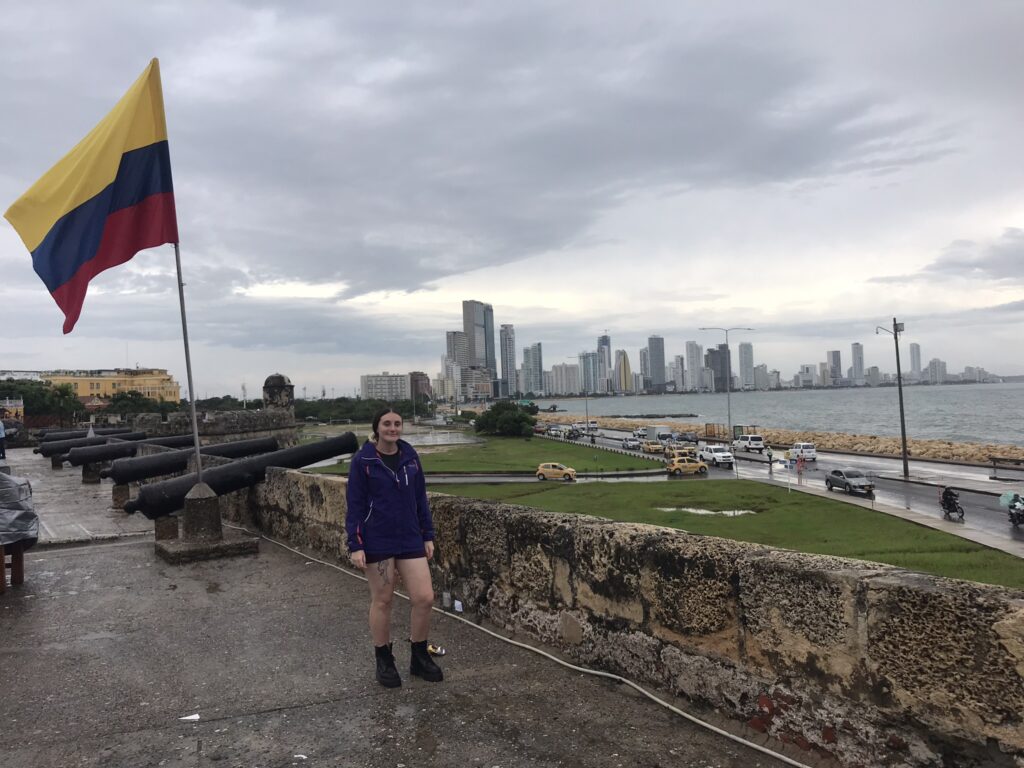
Walking on the old walls was one of the only things we could do during the flood
Activities
- Mostly hiding from the rain but we did manage to squeeze in an old city walking tour booked via Guruwalk
- Getsemani tour with Nexperience on Guruwalk – I recommend this tour as our guide was a lifelong resident of Getsemani and actually took us to his house, he knew all the residents in the neighbourhood and this was an unbeatable local experience, a highlight of our time in Cartagena
- Castle San Felipe de Barajas – large and imposing fortress which was good to explore for an hour or two
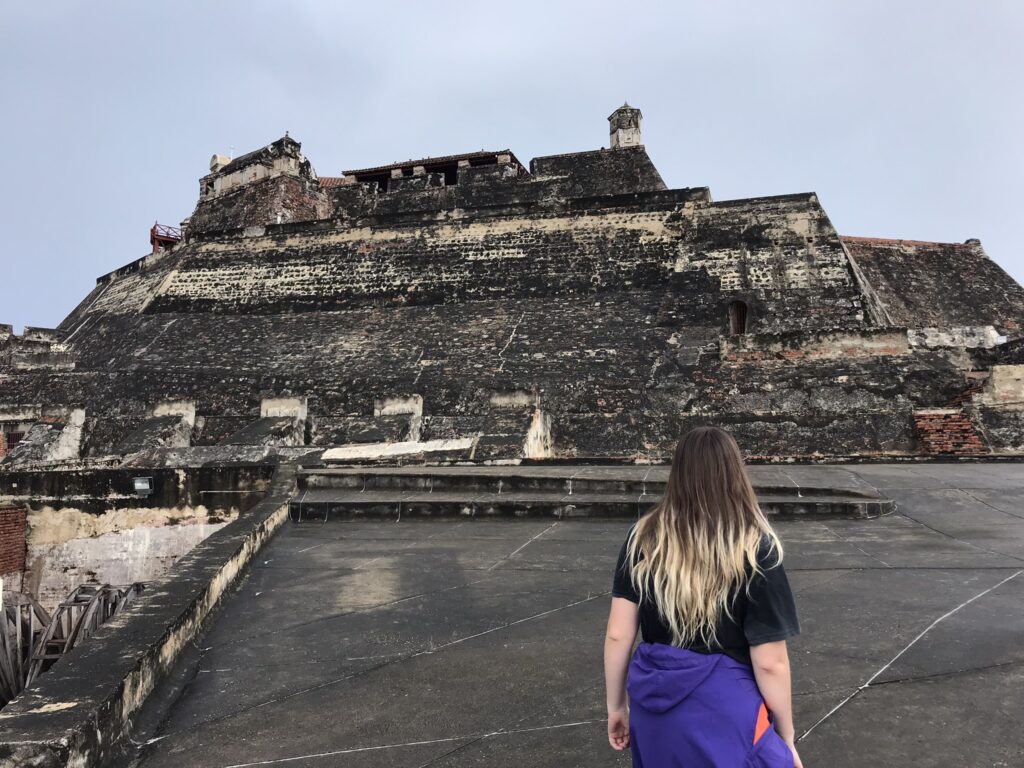
It was touch and go whether the castle would reopen before we had to move on
Foodie Places
- La Cevichería – a little pricey for Colombia but hands down one of the best places we ate at in South America, Anthony Bourdain visited this restaurant and his photo is still on the wall, you MUST try ceviche here, we also had seafood paella with brown rice and I still think to this day about how good it was!
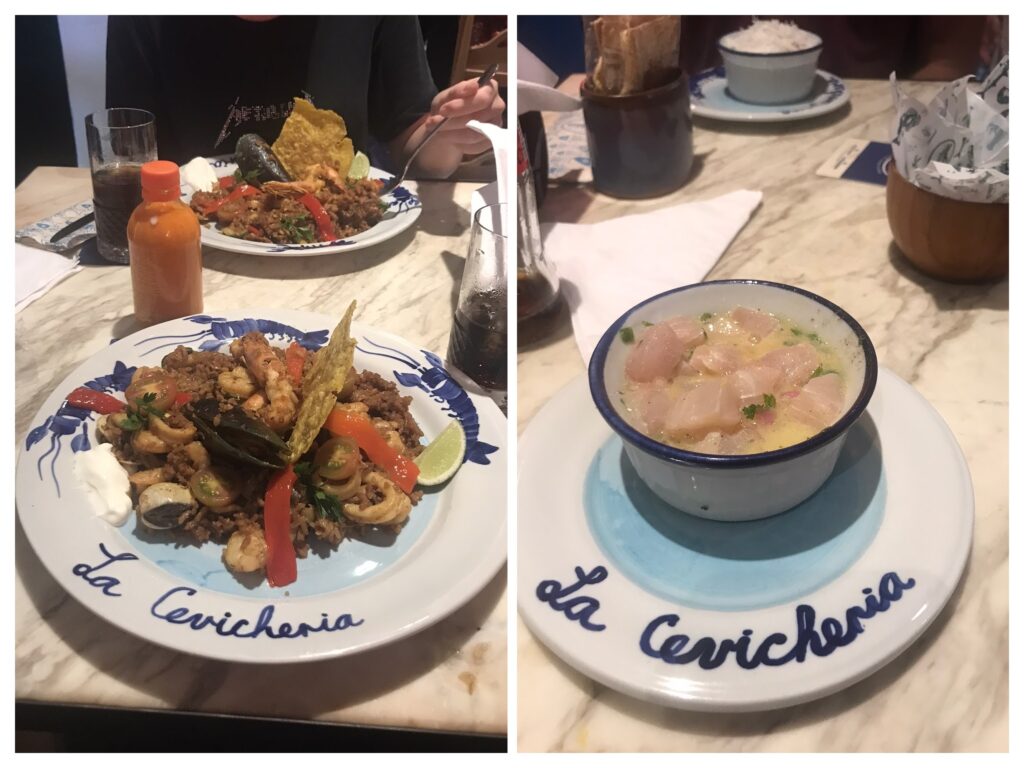
La Cevicheria, featured on Anthony Bourdain’s No Reservations
Medellin
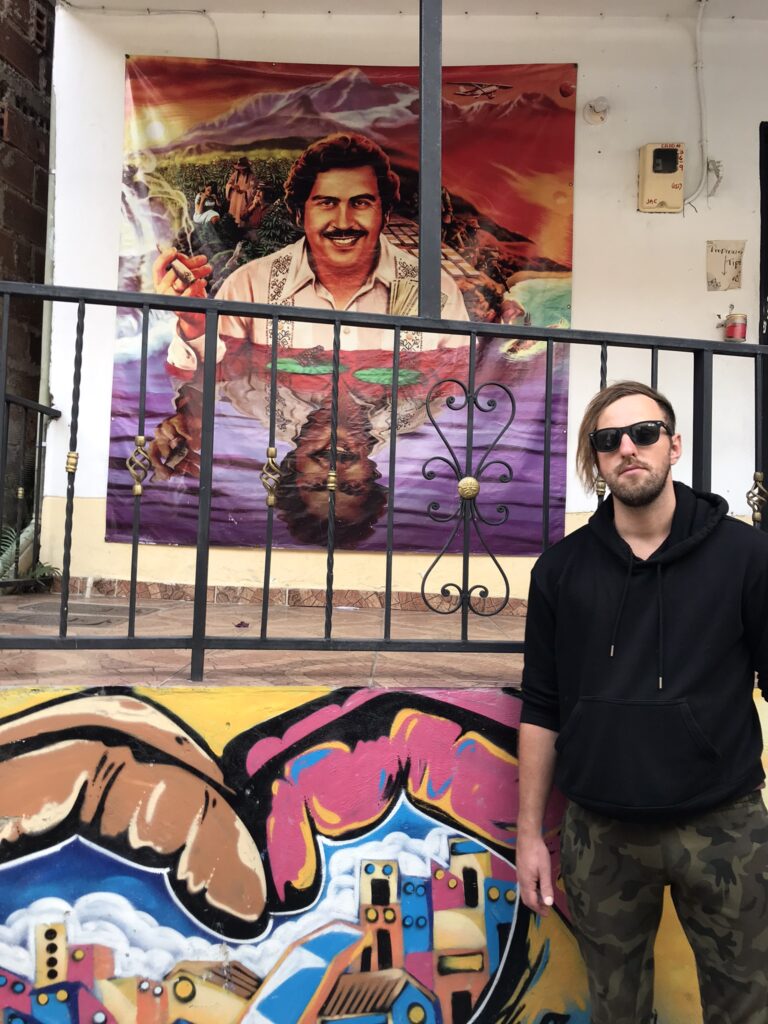
Dan with the man himself, Pablo Escobar
We made our first mistake in Medellin. I have to admit, it was my mistake too. I booked us into La Familia Hostel in Poblado (the main backpacker hotspot) and it turned out to be a party hostel. Whilst I don’t mind drinking and socialising until 11pm, it turned into a nightmare as the music, general drunken shit-talking and chairs scraping across the roof bar (right above our head as we were directly below) lasted until 2am. We had to get up at 5am the next day to go to Guatape. As you can imagine, we left quickly the next day to never return. We found restaurant prices to be very high in Poblado and it was too much of a ‘gringotown’ for our liking, we found out later that the neighbourhood was basically designed for tourists and was not a real representation of Medellin. We skedaddled to Prado with our tails between our legs. Prado is known as one of the worst, most dangerous neighbourhoods in Medellin but we were able to find a good, cheap and safe accommodation close enough to the metro line that it wasn’t too much of a problem.
Accommodation
La Familia Hostel – they do provide ear plugs and warn customers at check-in of the noise but ahhh we thought it was only the busy road outside that would bother us, ignorance is bliss! Probably a great place for people who want to drink and sing along to Britney Spears all night.
61Prado Hotel – highly recommend, huge bedrooms with breakfast included, I would issue this warning though, the area around this hotel is bad at night-time so we always ate at the hotel and were never disappointed, not only was the food great but the prices were much better than Poblado. You can walk around Prado in the day-time but you need to keep your wits about you.
Foodie Places
We found it quite expensive to eat out in Poblado and Prado was dangerous at night, so we stuck to 61Prado Hotel for meals.
Activities
- Casa Museo Pablo Escobar – entry is a bit on the expensive side but we enjoyed walking around the small exhibition about Pablo Escobar and gawking at his belongings and bullet-marked cars. The museum is owned by Escobar’s relatives and is located in one of his former stash-houses, the staff glorify Escobar and portray him as a hero and Robin Hood-type figure which was interesting.
- Guatape and El Peñol day trip organised through a tour company on tripadvisor. This was all doable in a day, although some people choose to stay overnight in Guatape the day trip was a great price and we didn’t feel like we rushed or missed anything. Great view from the top of El Peñol and Guatape was really pretty and picturesque to walk around, keep an eye out for the creative zocalos (tiles) that cover the colourful houses, a boat ride was also included.
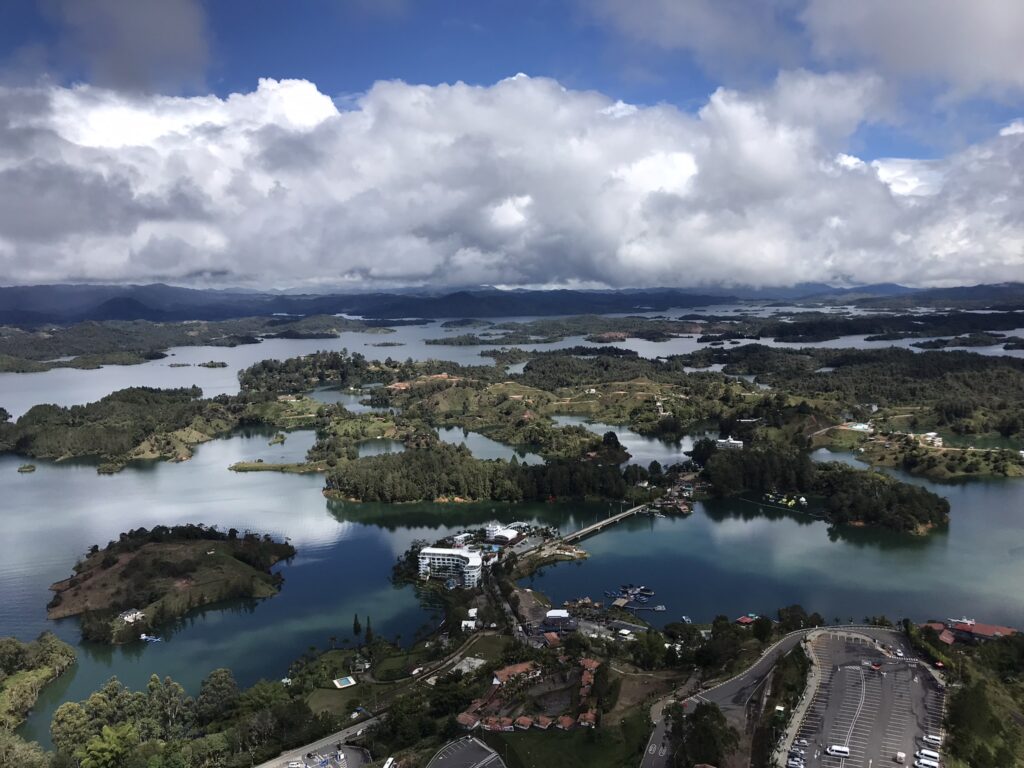
The view from the top of El Penol, you’ll definitely be out of breath after the climb!
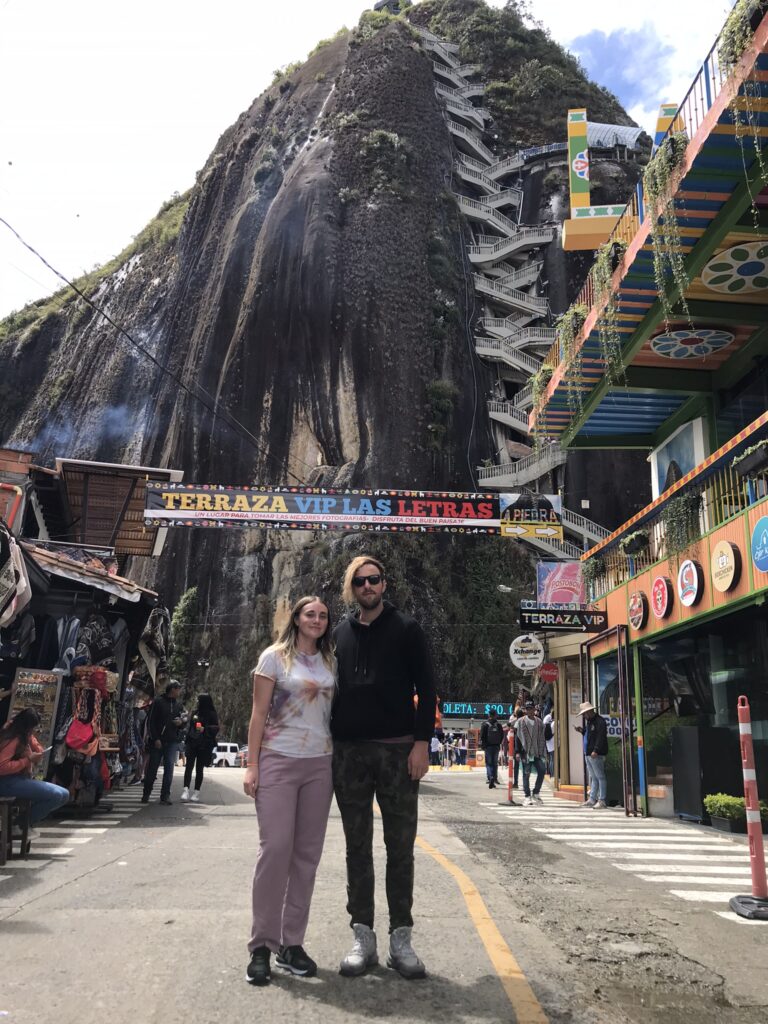
This was taken just before we almost got run over by a bus
- Communa 13 – reportedly one of the most dangerous places in the world only 20 years ago, we joined a tour group tour here with a young local guide which we booked online, we didn’t really know what to expect but the guide was very informative and told us about his upbringing and life in the community. We found that the area now feels very safe if a little on the touristy side, the locals are now employed in the tourism sector as tour guides, business owners or street sellers, there are escalators on the hills which avoids the steep climbs. We enjoyed walking around the communa which has a really strong community feel, an abundance of street art and some particularly good breakdancers.
- City centre walking tour booked through Guruwalk, the city centre is avoided by some who confine themselves to Poblado but this tour was really interesting and worthwhile, we learned and saw a lot including the infamous Botero bird sculpture that was used to conceal a bomb in a notorious terrorist attack during the city’s worst days. Our guide was a former member of the Colombian military and had some really fascinating insight
- Cable car around Medellin – one of the best and cheapest ways to travel around the city, it also provides interesting aerial views from above the different neighbourhoods of the city.
Salento
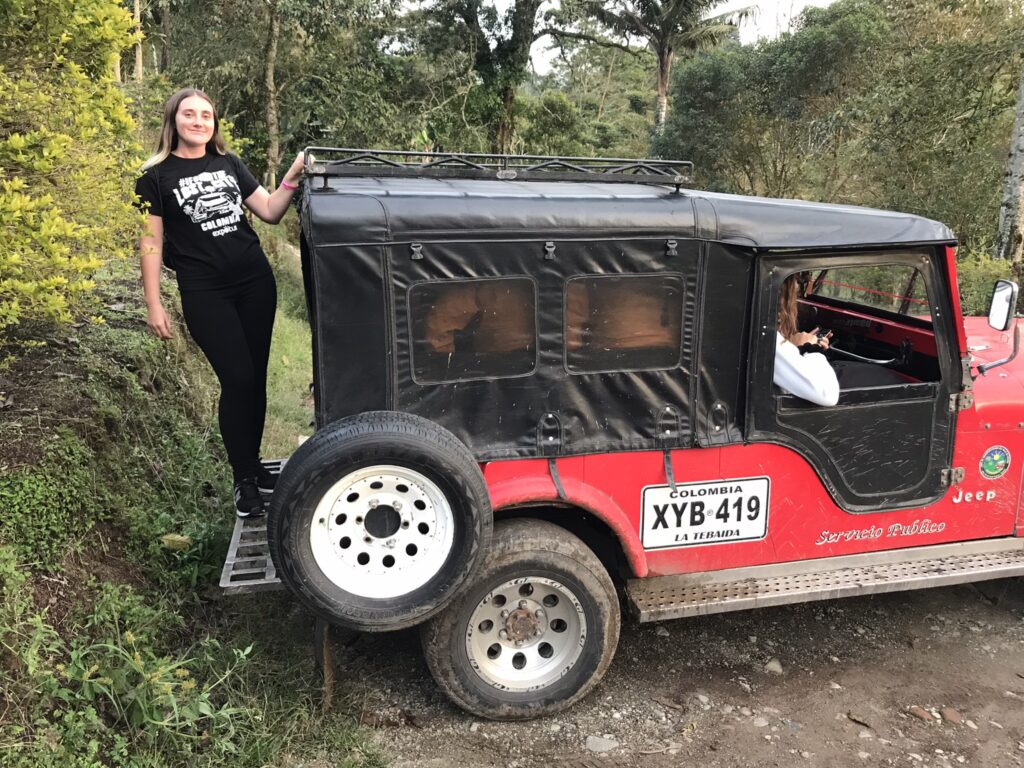
Me and the willy!
In the heart of the coffee-growing region, this is THE place to try Colombian coffee or, like me, stock up and carry it around for 2 months in my backpack. Salento is a small town but can be accessed by a direct bus from Medellin or from any of the surrounding cities like Pereira or Armenia. Plaza de Bolívar is the central hub of the town and the home of the willys! The willy is the local mode of transport, it is actually a landrover with seats in the back that takes visitors to the surrounding coffee farms, Cocora Valley and other local destinations. FYI the best ‘seats’ are actually outside the willy, standing on the back bumper and hanging on for dear life, you’ll get the best view and have the most fun by doing this but make sure to hold on tight! The willys are parked up in Salento in the main square and can easily be booked via a local kiosk to get you to all the main sights.
Accommodation
Hotel El Jardín Salento – highly recommend this pretty, colourful guesthouse!
Foodie Places
- Trattoria Urrea Salento
- Casa La Eliana – proper British curry, the owner lived in England for 20 years and speaks perfect English, thanks for the free beer!
Activities
- Coffee tour at Finca El Ocaso Salento – we did the premium coffee tour which took about 3 hours, this involved an in-depth coffee tasting session, picking coffee cherries on the plantation and being walked through the production process. I highly recommend this coffee farm and tour, the farm was easily accessed from Salento via willy.
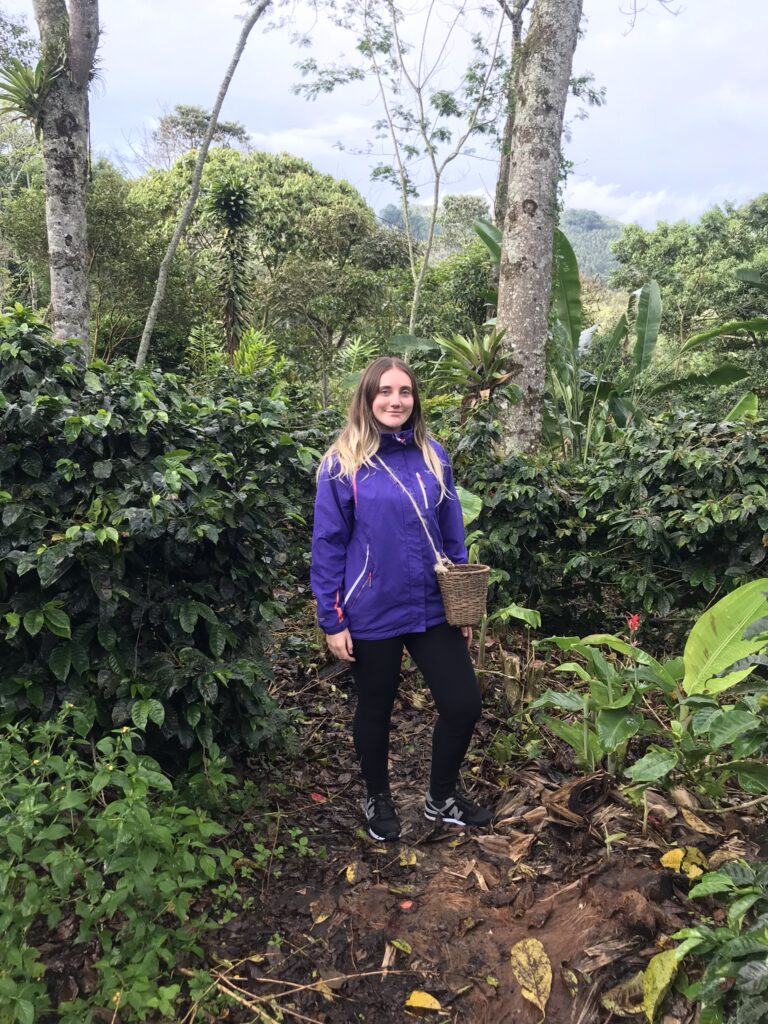
Picking coffee berries at Finca El Ocaso
- Mirador Alto de la Cruz – if you fancy an uphill walk close to the town centre this provided a good view from the top.
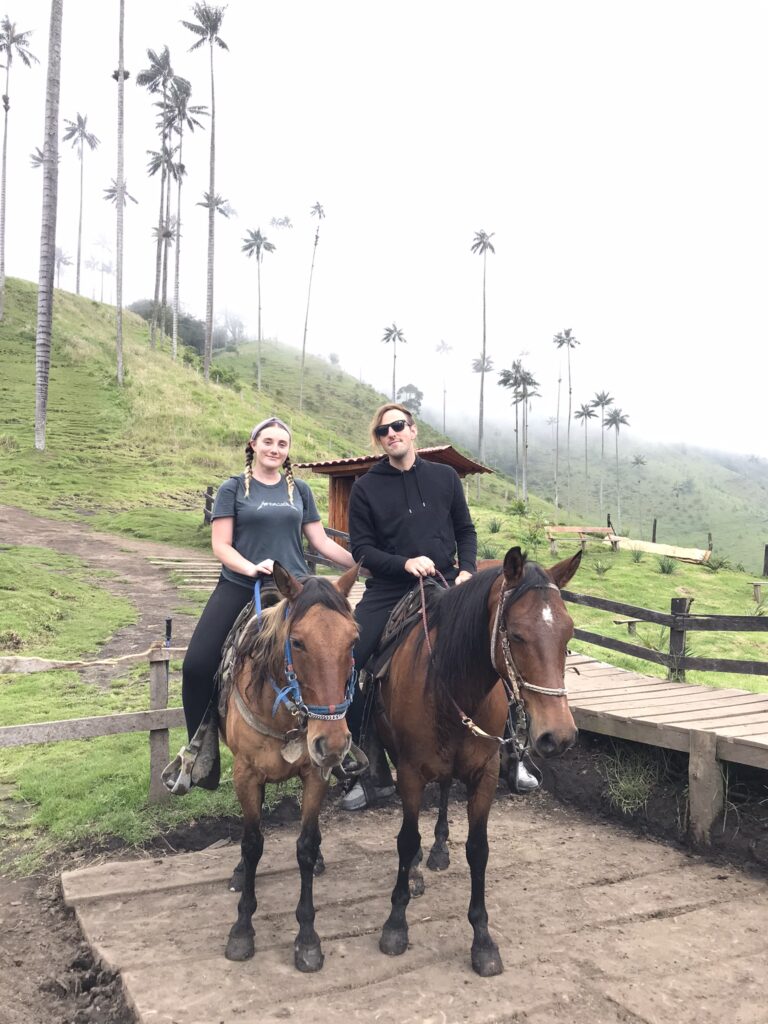
Channelling my inner cowgirl at Cocora Valley
- Horse-riding in Cocora Valley, now to confess, I am a horse-riding enthusiast and if there is ever an option to bypass walking and ride a horse, I will 100% do it. Experiencing Cocora Valley on horseback was an amazing experience, you’re surrounded by huge waxy palms, endemic only to the valley. There are great views from the top of the whole valley. When we got off the willy, we were approached by a man selling horse-rides around the valley and booked with him on the spot. Yes, we were probably ripped off but I’m not sorry about it at all.
Cali
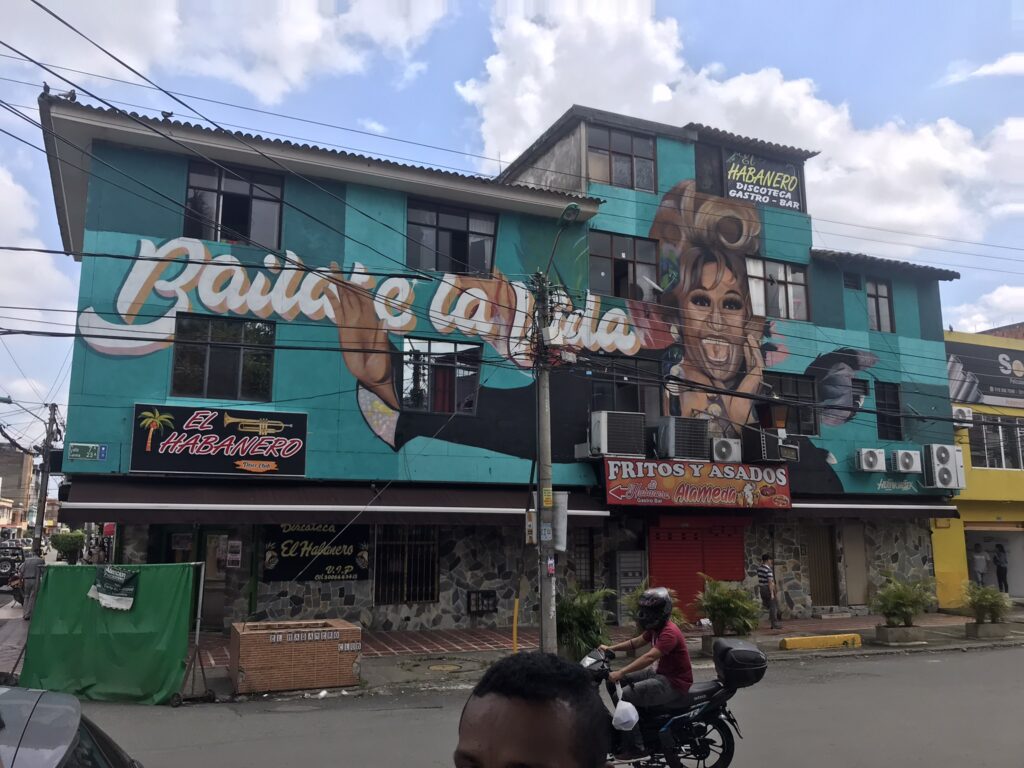
Salsa club in Cali
Salsa music is everywhere in Colombia, it’s just something you get used to. From taxi rides to restaurants, your ears will be constantly ringing with Grupo Niche or Joe Arroyo. Cali and Cartagena are the salsa hotspots in Colombia. Most hostels in Cali offer free salsa lessons, we found ourselves joining a class, the class was a mix of beginners and hostel residents who’d spent weeks perfecting their salsa in private classes. We were unaware that we’d be asked to switch partners, so already out of our comfort zone we acquiesced with questionable success. I found out that I have the ability to mess up every male partner’s rhythm, great! We didn’t do a whole lot here except salsa dance.
Accommodation
La Palmera Hostel and Coffee Shop – very popular place to stay
Oasis Cali Hostel – chilled out and very social but without being too noisy.
Foodie Places
- Suki Wok – good sushi, no complaints.
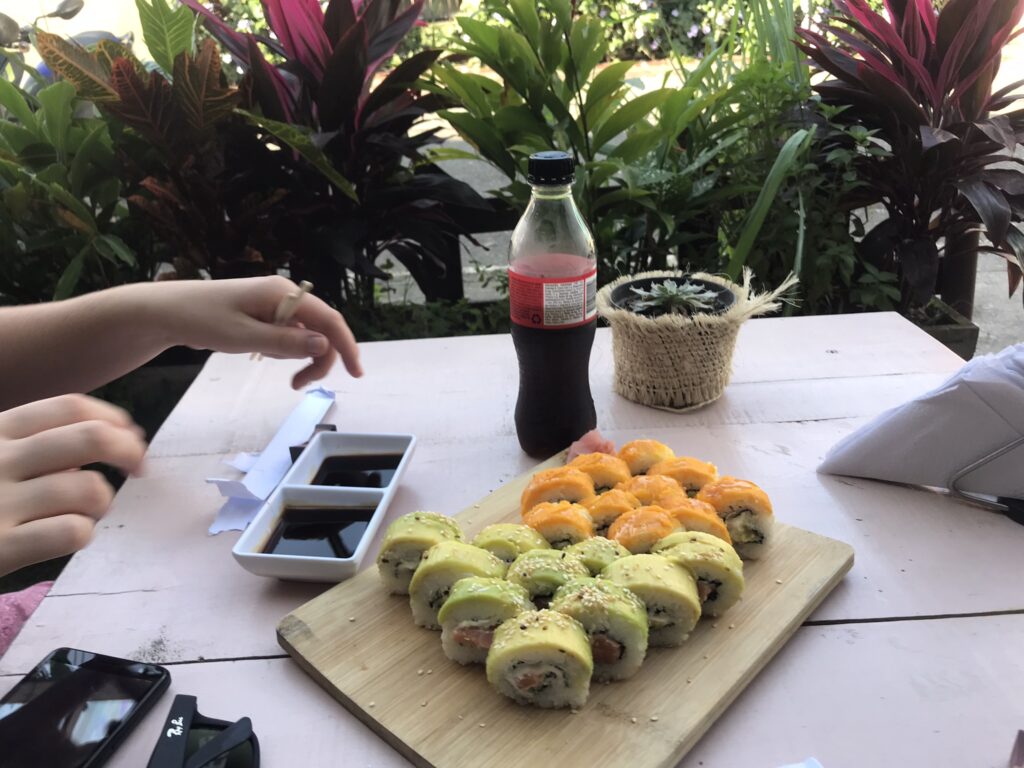
Sushi at Suki Wok
Activities
- Salsa street party – MUST DO, your hostel/hotel will know where the salsa street party is and when, it’s very busy and crowded as they close the street off just for the party, you can barely move but it’s a great thing to experience rubbing shoulders with the locals, sometimes the locals might take a liking to you and ask you to dance, especially if you’re a gringo male. You’ll hear the cowbell ringing in your ears the next morning!).
- City food tour with market visit included, booked through Guruwalk
- City centre walking tour which covered the main sites of the city and the area beside the Cali River, which is a popular and scenic spot to hang out. This was booked through a hostel, along the way the guide casually started talking to us about his interest in ayahuasca, which was unexpected to say the least
Many visitors take a trip to see the Cristo Rey statue which overlooks Cali. We didn’t do this as it the route was closed for repairs when we visited, plus we had already seen or were planning to see similar statues in Havana, Cusco and of course the famous Christ the Redeemer in Rio de Janeiro. The Cristo Rey is an important part of Cali’s skyline though and can be easily visited for a closer look and an aerial view of the city if the route is open.
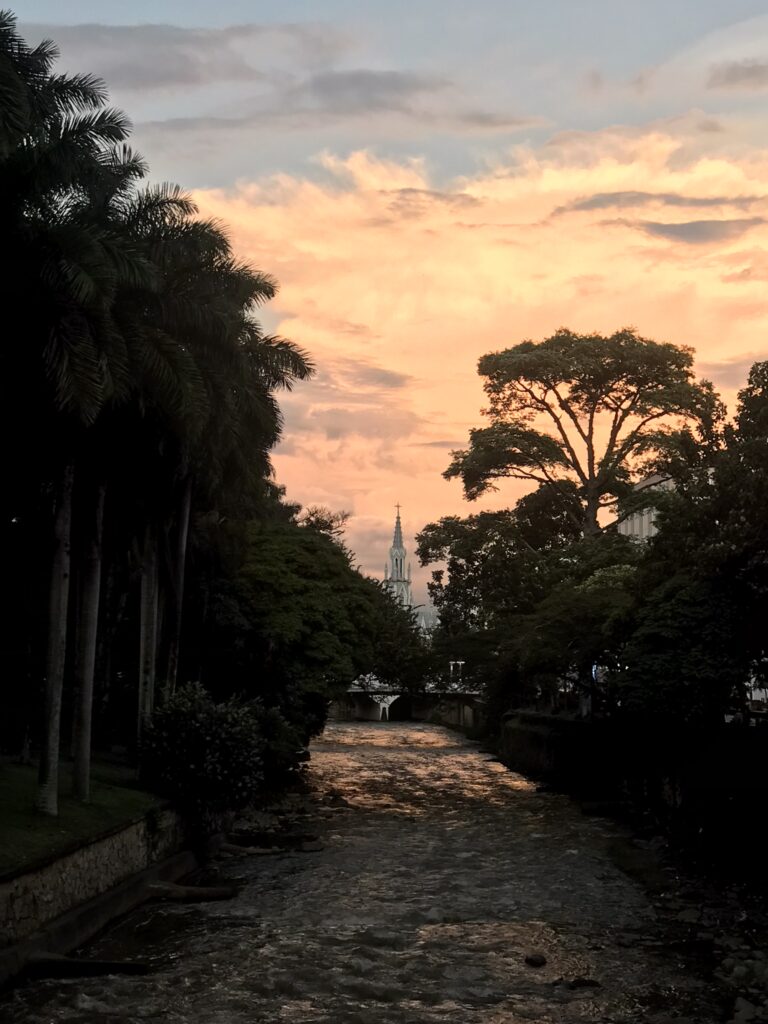
Sunset in the city centre, Cali
Crossing the Colombian/Ecuadorian Border at Ipiales
The only border crossing between Colombia and Ecuador that is advised for travellers is at the town of Ipiales. Most people get the night bus to Ipiales from Cali, although this route is known to be frequented by criminal gangs it is still probably the wisest option to take the night bus as this means you arrive in Ipiales in the morning when it’s light. We decided to get the day bus from Cali, we arrived to the bus station early only to be told that our scheduled bus was cancelled and that we would need to wait two hours to get another bus. This second bus then took much longer than expected which meant we didn’t get to Ipiales until after 10pm. Luckily our hotel was able to take us in at this time but it was a dodgy situation to say the least.
Ipiales bus station (and the entire town in fact) is NOT a good place to be at night, we virtually ran from the bus straight to our hotel less than 100m away because we felt so unsafe.
We stayed at Hotel San José, just within running distance of the bus station.
You don’t want to hang around in Ipiales, it’s an ugly border town. The shops have their doors locked and metal shutters closed even when they are open, it’s that sort of place. You won’t find much hospitality here, it’s best to keep your stay to a minimum and move on.
However Ipiales does have one attraction, the beautiful 18th century gothic style church nearby at Las Lajas. You can jump in an collectivo from Ipiales opposite the entrance to the bus station which will drop you off at Las Lajas, from there you can easily walk to the church and sanctuary. Las Lajas felt like a different planet to Ipiales and it was heard to believe that the two places were so close together.
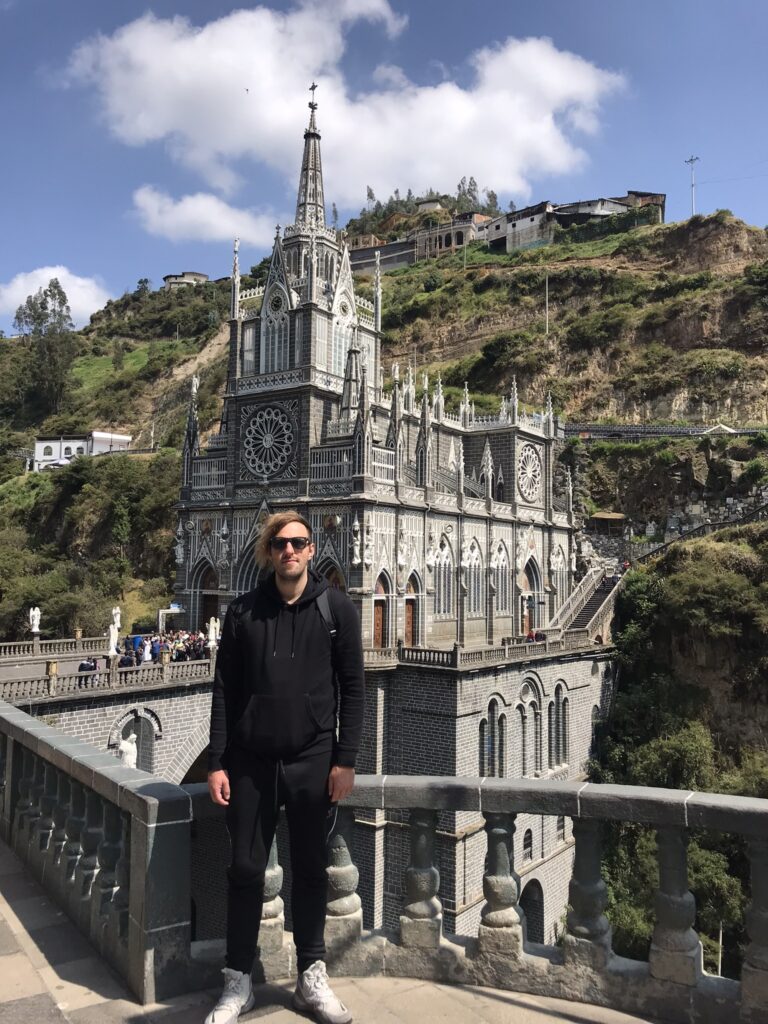
Las Lajas is a great stop off before crossing the border
Next, the actual border crossing. It is possible to get a collectivo to the border (frontera) from outside the bus station in Ipiales, these depart from the same place as the collectivos to Las Lajas. When arriving you will see the border points are on either side of the Rumichaca bridge, you need to remember to queue to get the stamp to leave Colombia, walk across the bridge and then also get the entrance stamp for Ecuador before proceeding. We decided to get up early, visit Las Lajas and then get some food in Ipiales before heading to the border, in hindsight this was a mistake as we arrived at the border around midday. By this time there was a huge mass of people queueing indiscriminately at the Colombian border station. It took us over 4 hours to get the stamp to leave Colombia. The queueing system on the Colombian side of the border was by far the worst we experienced in South America. What was more infuriating was that they had a perfectly good system set up with multiple queuing lanes signposted for people entering and leaving the country, but for unknown reasons this system was being ignored by the border officials, instead everyone was directed into one enormous queue no matter whether they were entering or leaving the country. Most of those trying to enter Colombia had to be interviewed and have their permits checked by immigration officials which slowed down the process. There was also a fast lane for Colombian citizens, who we found were being given precedence over everyone else at the front of the very long, slow queue. By the end of the four hour ordeal we had to stop ourselves from shouting at the border guards, it was that bad. Best advice: arrive earlier than we did or expect to be there for ages. Once we were at the front of the queue at the Colombia side we were stamped straight away, we then walked across the border and it took us less than 5 minutes to get the entrance stamp for Ecuador. Jeez!
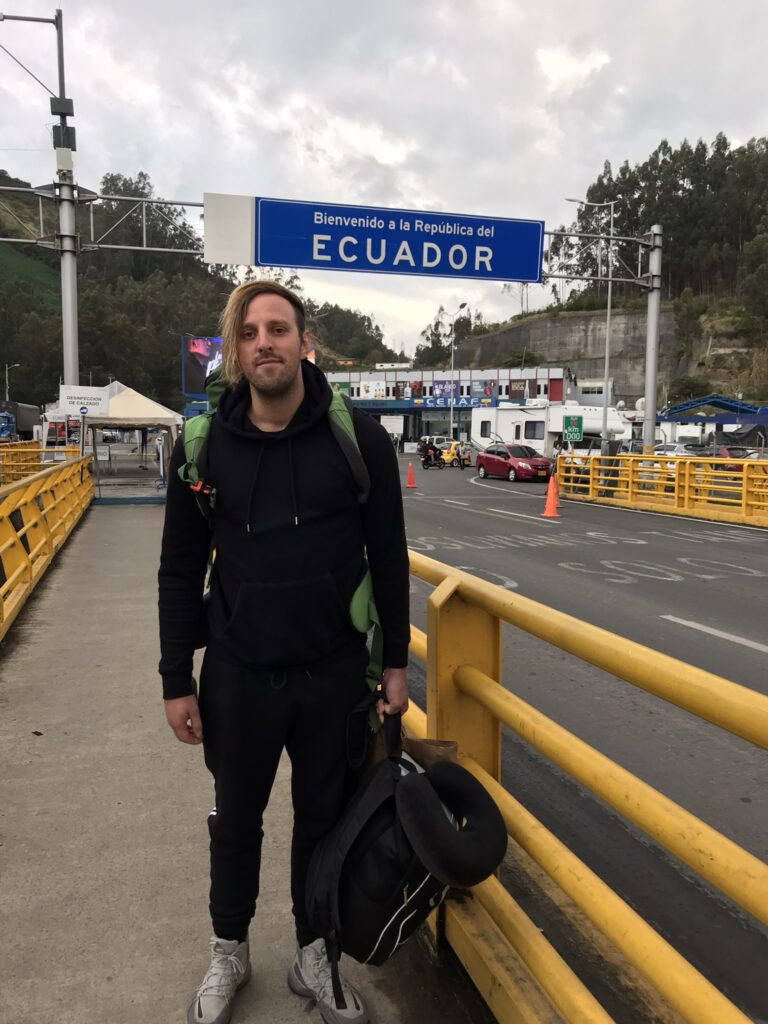
Walking across the Colombian border to Ecuador
Once the immigration process is finished you can get a collectivo from the Ecuadorian side of the border on to Tulcan, the nearest town in Ecuador. Just behind the immigration office in the car park adjoining is where the collectivos leave for Tulcan bus station. From Tulcan, you can get a bus to Quito via Otavalo.
